
W.K. Kellogg Foundation
Logic Model Development Guide


Using Logic Models to Bring Together Planning, Evaluation, and Action
Logic Model Development Guide
To help people help themselves through the practical
application of knowledge and resources to improve
their quality of life and that of future generations.
Updated January 2004
W.K. Kellogg Foundation
One East Michigan Avenue East
Battle Creek, Michigan 49017-4058
www.wkkf.org
To receive additional copies of the Logic Model Development Guide,
please call 1/800/819-9997 and request item #1209.
W.K. KELLOGG
FOUNDATION


Introduction ..........................................................................................................III
Chapter 1
Introduction to Logic Models ........................................................................................1
The What and Why of the Logic Model ........................................................................1
Logic Model Definition ............................................................................................1
Logic Model Purpose ................................................................................................3
Trip Planning Logic Model Example..........................................................................3
Why Use a Logic Model?................................................................................................5
Program Success ..........................................................................................................5
Program Investments ..................................................................................................6
Simple Logic Model Basics ............................................................................................7
Logic Model Development..........................................................................................7
Reading a Logic Model ..............................................................................................7
Other Logic Model Examples ........................................................................................8
Theory Model ..........................................................................................................10
Outcomes Model ......................................................................................................11
Activities Model ........................................................................................................12
Chapter 2
Developing a Basic Logic Model for Your Program ......................................................15
Demonstrating Progress Toward Change ......................................................................16
Exercise 1 – Describing Results ....................................................................................16
Exercise 1 Checklist......................................................................................................20
Exercise 2 – Describing Actions....................................................................................21
Exercise 2 Checklist......................................................................................................23
Program Implementation Template – Exercise 1 & 2 ..................................................25
Chapter 3
Developing a Theory-of-Change Logic Model for Your Program..................................27
Exercise 3 - Constructing a Program Theory ................................................................28
Program Planning ......................................................................................................28
Exercise 3 Checklist....................................................................................................33
Program Planning Template – Exercise 3....................................................................34
Logic Model Development GuidePage I
Contents
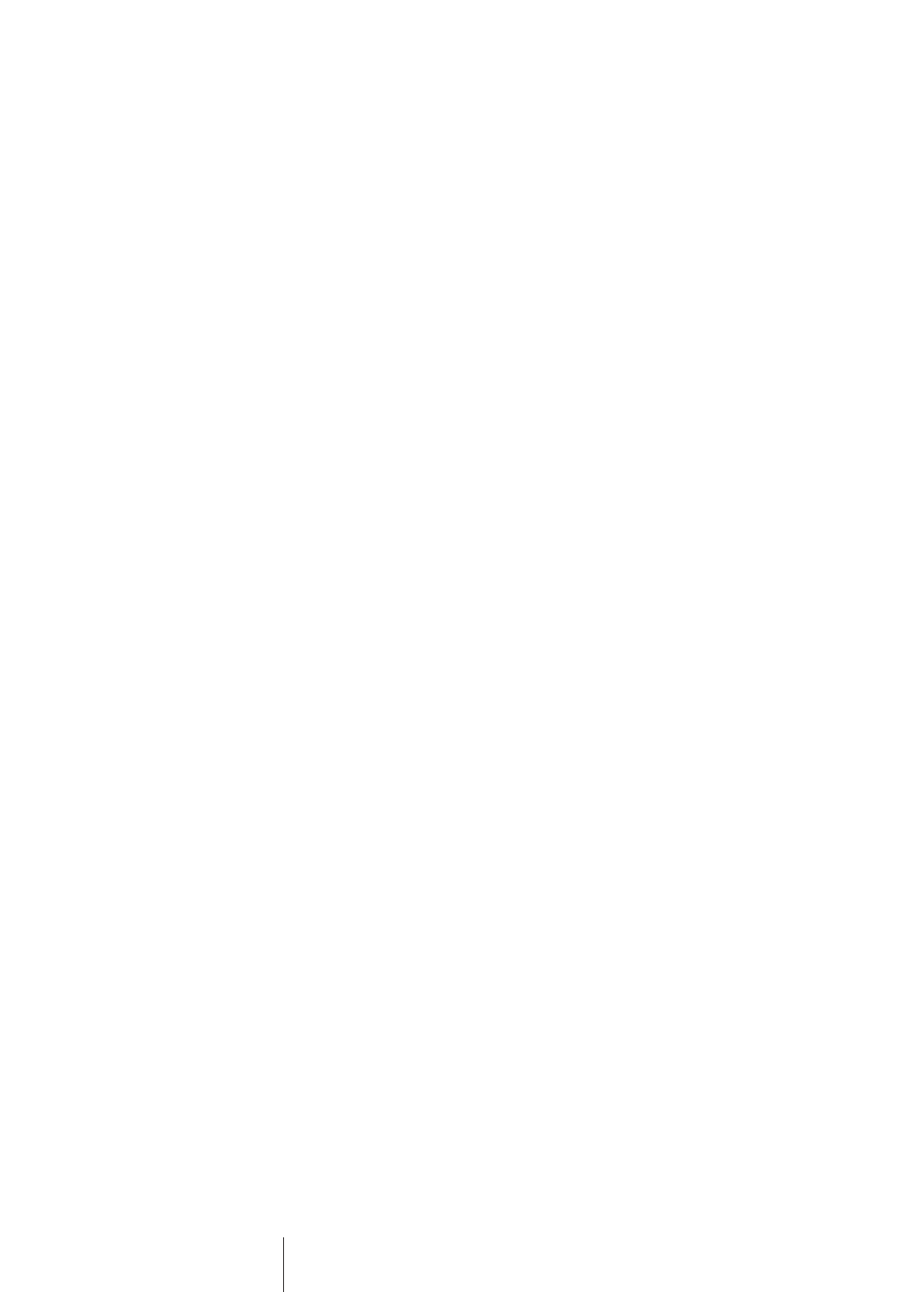
Chapter 4
Using Your Logic Model to Plan for Evaluation ..........................................................35
Exercise 4 – Posing Evaluation Questions ....................................................................35
Formative/Summative Evaluation Questions ............................................................35
Evaluation Vantage Points Context, Implementation, Outcomes ..............................36
Focus Areas, Audiences, Questions, Information Use ................................................38
Audiences and Evaluation..........................................................................................42
Exercise 4 Checklist ..................................................................................................43
Evaluation Planning Template – Exercise 4 ..................................................................44
Exercise 5 – Establishing Indicators..............................................................................45
Indicators of Success..................................................................................................45
Exercise 5 Checklist ..................................................................................................47
Indicators Development Template – Exercise 5 ........................................................48
Resource Appendix ........................................................................................49
Forms Appendix ................................................................................................53
Logic Model Development GuidePage II

Introduction
If you don’t know where you’re going, how are you gonna’ know when you get there?
–Yogi Berra
In line with its core mission – To help people help themselves through the practical application of knowledge
and resources to improve their quality of life and that of future generations – the W.K. Kellogg Foundation has
made program evaluation a priority. As our staff and grantees work on a spectrum of social improve-
ment programs, the need for shaping and contributing to the body of knowledge regarding evaluation
becomes increasingly clear. Our first guide, the W.K. Kellogg Foundation Evaluation Handbook, was pub-
lished in 1998, and has been made available to nearly 7,500 people.The Evaluation Handbook is a prac-
tical, step-by-step manual for conducting evaluations.With the Handbook, we introduced the concept
of the program logic model and the ways in which applying this concept has added value to our
own work.
The program logic model is defined as a picture of how your organization does its work – the theory and
assumptions underlying the program. A program logic model links outcomes (both short- and long-term)
with program activities/processes and the theoretical assumptions/principles of the program.
The W.K. Kellogg Foundation Logic Model Development Guide, a companion publication to the Evaluation
Handbook, focuses on the development and use of the program logic model.We have found the logic
model and its processes facilitate thinking, planning, and communications about program objectives and
actual accomplishments.Through this guide, we hope to provide an orientation to the underlying prin-
ciples and language of the program logic model so it can be effectively used in program planning,
implementation, and dissemination of results.
The premise behind this guide – and our view of the role of evaluation in programming – is simple:
Good evaluation reflects clear thinking and responsible program management. Over the years, our
experience in using logic models in initiatives such as the Kellogg Youth Initiative Partnerships,
Devolution, ENLACE (Engaging Latino Communities for Education), and the Native American
Higher Education Initiative, to name just a few, has provided ample evidence of the effectiveness of
these methods.
Learning and using tools like logic models can serve to increase the practitioner’s voice in the domains
of planning, design, implementation, analysis, and knowledge generation.The process of developing the
model is an opportunity to chart the course. It is a conscious process that creates an explicit under-
standing of the challenges ahead, the resources available, and the timetable in which to hit the target. In
addition, it helps keep a balanced focus on the big picture as well as the component parts.
In general, logic modeling can greatly enhance the participatory role and usefulness of evaluation as a
management and learning tool. Developing and using logic models is an important step in building
community capacity and strengthening community voice.The ability to identify outcomes and antici-
pate ways to measure them provides all program participants with a clear map of the road ahead. Map
in hand, participants are more confident of their place in the scheme of things, and hence, more likely
to actively engage and less likely to stray from the course – and when they do, to do so consciously
and intentionally. Because it is particularly amenable to visual depictions, program logic modeling can
be a strong tool in communicating with diverse audiences – those who have varying world views and
different levels of experience with program development and evaluation.
Logic Model Development GuidePage III

Introduction
The Logic Model Development Guide contains four chapters and two comprehensive appendices.
Chapter 1 presents a basic introduction to the logic model as an action-oriented tool for program
planning and evaluation. It also offers an array of sample logic models.
Chapter 2 consists of exercises and examples focused on the development of a simple program logic
model. Exercises include practical examples, checklists for reviewing content quality, and a template
for developing a logic model.
Chapter 3 gives instructions on how to expand a basic logic model to explore and explain the theory-
of-change that describes the rationale for your program. A template and checklist are provided.
Chapter 4 offers two exercises that afford the reader with an introduction to how the basic logic
modeling techniques introduced in the previous chapters can be applied to inform thinking about
what should be included in an evaluation plan.Templates and checklists are also provided.
The Resources Appendix provides logic model development resources – references and Web sites worth
visiting.The Forms Appendix includes blank templates to copy when developing your own logic models.
Acknowledgements
This work builds on the experience of many at the W.K. Kellogg Foundation who pioneered the appli-
cation of logic modeling to their initiatives. For example, logic models were first used with the Kellogg
Youth Initiative Partnerships (KYIP). In this application, the models were instrumental in helping staff
establish program direction, implementation, an evaluation framework, and outcomes across three sites.
In KYIP, logic modeling was used to facilitate and guide the development of the specific assumptions
and processes that ultimately led to the transition of the initiative from a WKKF-operated program to a
community-owned program.WKKF program staff, including Tyrone Baines, Phyllis Meadows, Gerald
Smith, Judy Watson Olson, Steve Peffers, Joyce Brown, and John Seita were instrumental in these efforts.
Our work in developing the Logic Model Development Guide began at the request of Kellogg Foundation
Program Director Blas Santos who expressed a need for user-friendly tools and processes to support the
work of grantees in Latin America and the Caribbean.
The Logic Model Development Guide represents a collaborative effort.We particularly want to acknowl-
edge the efforts of the Kellogg Foundation’s former director of evaluation, Ricardo Millett, and his
team of evaluation managers, including Astrid Hendricks-Smith and Mark Lelle, who have since left
the organization.Their tireless work among staff and grantees continues to promote the use of logic
models to plan, design, and manage initiatives. Dale Hopkins and Karin Ladley were instrumental in
bringing the material to print.We also wish to acknowledge the work of the Kellogg Foundation Vice
Presidents of Programs Rick Foster, Gail McClure, Dan Moore, and Gloria Smith, along with Senior
Vice President of Programs Anne Petersen, who have underscored the importance of evaluation,
embraced the logic model approach, and adopted it as a valued program support tool.
Special thanks are extended to Cynthia Phillips, a primary writer and consultant throughout the
development of this guide, and Work Volk Consultants, LLP, for formatting and editorial assistance.
Thanks, also, to Beverly Parsons of In Sites; Andrew Hahn and the students at the Florence Heller
Graduate School for Advanced Studies in Social Welfare, Brandeis University; Marc Osten, Summit
Consulting Collaborative; Sally Bond,The Program Evaluation Group; Joel Meister and Eva Moya,
University of Arizona; Amy Coates-Madsen and staff at Maryland Association of Nonprofit
Organizations; and Gail Randall, Greater Worchester Community Foundation.
–The Program Staff of the W.K. Kellogg Foundation
Logic Model Development GuidePage IV
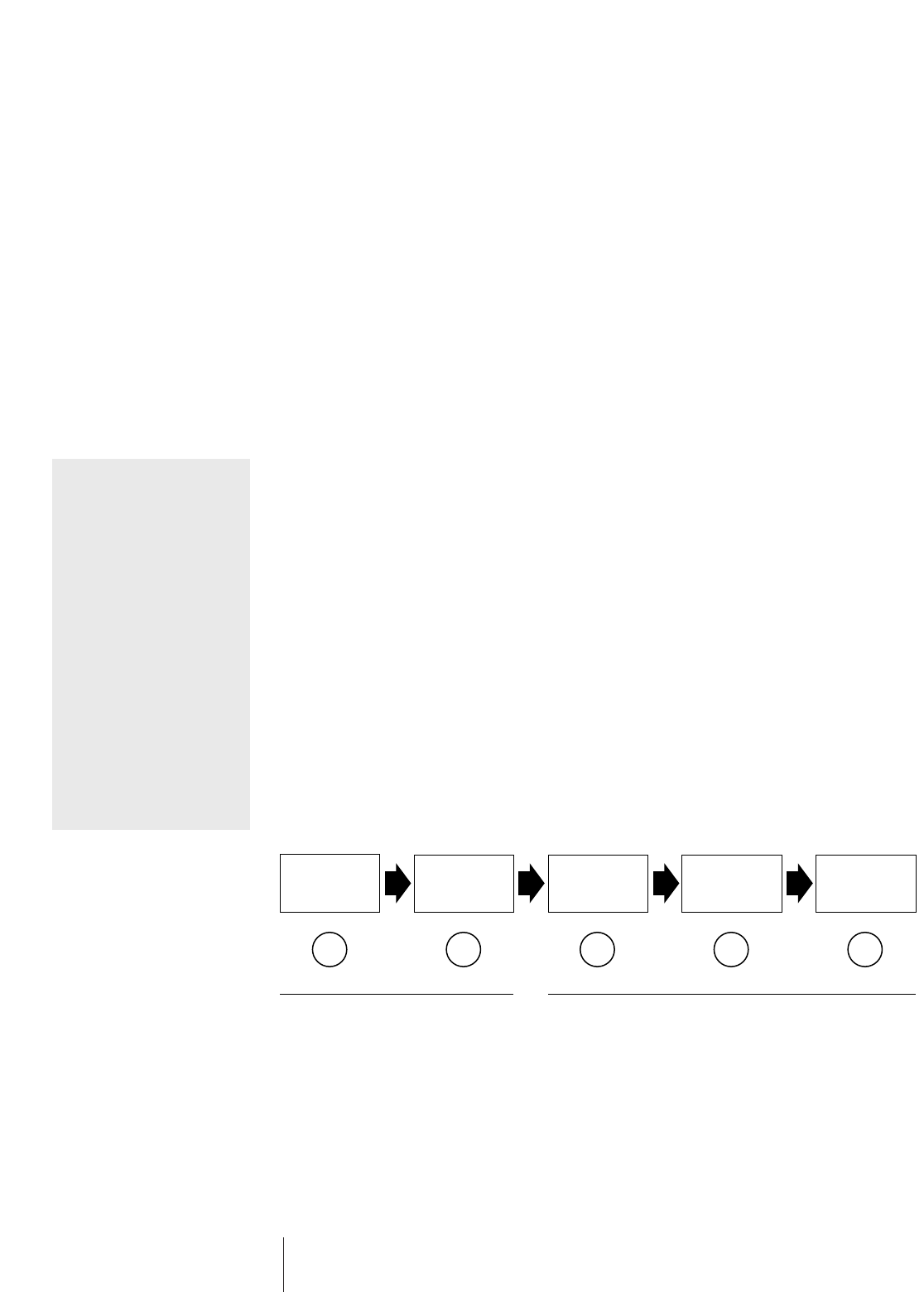
Introduction to Logic Models
Chapter One defines logic models and explains their usefulness to program stakeholders. You
will learn the relevance of this state-of-the-art tool to program planning, evaluation, and
improvement.
E
ffective program evaluation does more than collect, analyze, and provide data. It
makes it possible for you – program stakeholders – to gather and use information,
to learn continually about and improve programs that you operate in or fund.
The W.K. Kellogg Foundation believes evaluation – especially program logic model
approaches – is a learning and management tool that can be used throughout a program’s
life – no matter what your stake in the program. Using evaluation and the logic model
results in effective programming and offers greater learning opportunities, better docu-
mentation of outcomes, and shared knowledge about what works and why. The logic
model is a beneficial evaluation tool that facilitates effective program planning, imple-
mentation, and evaluation.
The What and Why of the Logic Model
The WHAT: Logic Model Definition
Basically, a logic model is a systematic and visual way to present and share your under-
standing of the relationships among the resources you have to operate your program, the
activities you plan, and the changes or results you hope to achieve.
Figure 1. The Basic Logic Model.
The most basic logic model is a picture of how you believe your program will work. It uses
words and/or pictures to describe the sequence of activities thought to bring about change
and how these activities are linked to the results the program is expected to achieve.
Logic Model Development GuidePage 1
A program logic model is a
picture of how your pro-
gram works – the theory
and assumptions underly-
ing the program. ...This
model provides a road map
of your program, high-
lighting how it is expected
to work, what activities
need to come before others,
and how desired outcomes
are achieved (p. 35).
W.K. Kellogg
Foundation Evaluation
Handbook (1998)
Chapter 1
Resources/
Inputs
Activities Outputs Outcomes Impact
1 5432
Your Planned Work Your Intended Results

The Basic Logic Model components shown in Figure 1 above are defined below. These
components illustrate the connection between your planned work and your intended results.
They are depicted numerically by steps 1 through 5.
YOUR PLANNED WORK describes what resources you think you need to implement
your program and what you intend to do.
1. Resources include the human, financial, organizational, and community resources a
program has available to direct toward doing the work. Sometimes this component
is referred to as Inputs.
2. Program Activities are what the program does with the resources. Activities are the
processes, tools, events, technology, and actions that are an intentional part of the program
implementation. These interventions are used to bring about the intended program
changes or results.
YOUR INTENDED RESULTS include all of the program’s desired results (outputs, out-
comes, and impact).
3. Outputs are the direct products of program activities and may include types, levels and
targets of services to be delivered by the program.
4. Outcomes are the specific changes in program participants’ behavior, knowledge, skills,
status and level of functioning. Short-term outcomes should be attainable within 1 to 3
years, while longer-term outcomes should be achievable within a 4 to 6 year timeframe.
The logical progression from short-term to long-term outcomes should be reflected in
impact occurring within about 7 to 10 years.
5. Impact is the fundamental intended or unintended change occurring in organizations,
communities or systems as a result of program activities within 7 to 10 years. In the cur-
rent model of WKKF grantmaking and evaluation, impact often occurs after the conclu-
sion of project funding.
The term logic model is frequently used interchangeably with the term program theory in
the evaluation field. Logic models can alternatively be referred to as theory because they
describe how a program works and to what end (definitions for each employed by leading
evaluation experts are included in the Resources Appendix).
The What: How to “Read” a Logic Model
When “read” from left to right, logic models describe program basics over time from
planning through results. Reading a logic model means following the chain of reasoning
or “If...then...” statements which connect the program’s parts. The figure below shows
how the basic logic model is read.
Logic Model Development GuidePage 2
Most of the value in a logic
model is in the process of
creating, validating, and
modifying the model …
The clarity of thinking
that occurs from building
the model is critical to the
overall success of the pro-
gram (p. 43).
W.K. Kellogg Foundation
Handbook (1998)
Chapter 1

Figure 2. How to Read a Logic Model.
The WHY: Logic Model Purpose and Practical Application
The purpose of a logic model is to provide stakeholders with a road map describing the
sequence of related events connecting the need for the planned program with the pro-
gram’s desired results. Mapping a proposed program helps you visualize and understand
how human and financial investments can contribute to achieving your intended program
goals and can lead to program improvements.
A logic model brings program concepts and dreams to life. It lets stakeholders try an idea on
for size and apply theories to a model or picture of how the program would function. The
following example shows how the logic model approach works. (If you are familiar with logic
models, you may wish to skip ahead to the section entitled “Why Use A Logic Model?”)
Logic Model Development GuidePage 3
Sample Factors
influencing the trip:
• Family members’ school
and work schedules
• The holidays
• Winter weather
• Frequent Flier availability
Sample Activities:
• Creating/checking family
schedules
• Gathering holiday flight
and FF information
• Getting airport
transportation
• Notifying Iowa relatives
An Example:
We are proposing an inexpensive family trip from Charleston, South Carolina, to Des Moines, Iowa,
to visit relatives during December school holidays. The seasonal trip we dream of taking from
Charleston to Des Moines is the “program.” Basic assumptions about our trip “program” are:
• We want to visit relatives between 12/10/00 and 1/5/01 while the children are out of school.
• We will fly from South Carolina to Iowa because it takes less time than driving and because
frequent flier (FF) miles are available.
• Using frequent flier miles will reduce travel costs.
We have to determine the factors influencing our trip, including necessary resources, such as, the
number of family members, scheduled vacation time, the number of frequent flier miles we have,
round trip air reservations for each family member, and transportation to and from our home to
the airport. The activities necessary to make this happen are the creation of our own family holiday
schedule, securing our Iowa relative’s schedule, garnering air line information and reservations
and planning for transportation to and from the airport.
Resources/
Inputs
Activities Outputs Outcomes Impact
Certain
resources are
needed to
operate your
program
If you have
access to
them, then you
can use them
to accomplish
your planned
activities
If you
accomplish
your planned
activities, then
you will
hopefully deliver
the amount of
product and/or
service that
you intended
If you
accomplish
your planned
activities to the
extent you
intended, then
your participants
will benefit in
certain ways
If these
benefits to
participants are
achieved, then
certain changes
in organizations,
communities,
or systems
might be
expected to
occur
1 5432
Your Planned Work Your Intended Results

In this example, the results of our activities – or outputs – are mostly information, such as
family schedules, flight schedules, and cost information based on the time frame of the trip.
This information helps identify outcomes or immediate goals. For instance, if we make
reservations as soon as possible, we are able to find flights with available frequent flier slots
and probably have more options for flights that fit within the time frame. Knowing this,
our outcomes improve – reservations made well in advance result in flight schedules and
airline costs that suit our timeline and
travel budget. Longer-term impact of our trip is not
an issue here, but might be projected as continued good family relationships in 2010.
Using a simple logic model as a trip-planning tool produced tangible benefits. It helped
us gather information to influence our decisions about resources and allowed us to meet
our stated goals. Applying this process consistently throughout our trip planning posi-
tions us for success by laying out the best course of action and giving us benchmarks for
measuring progress – when we touch down in Charlotte and change planes for
Cincinnati, we know we’re on course for Des Moines.
Typical logic models use table and flow chart formats like those presented here to cata-
logue program factors, activities, and results and to illustrate a program’s dimensions.
Most use text and arrows or a graphic representation of program ideas. This is what our
trip planning “program” could look like in logic model format.
It was easy to organize travel plans in a flow chart, but we could also choose to organize and
display our thinking in other ways. A logic model does not have to be linear. It may appear
as a simple image or concept map to describe more complex program concepts. Settling on
a single image of a program is sometimes the most difficult step for program stakeholders.
Logic Model Development GuidePage 4
You can’t do “good” evalua-
tion if you have a poorly
planned program.
Beverly Anderson Parsons
(1999)
Resources/
Inputs
Activities Outputs Outcomes Impact
Holiday
flight
schedules
Family
schedules
Frequent
flyer
holiday
options
Holiday
weather
Create
family
schedule
Get
holiday
flight info
Get
tickets
Arrange
ground
transport
Tickets
for all
family
members
Frequent
flyer miles
used
Money
saved
Family
members
enjoy
vacation
Continued
good
family
relations
1 5432
Your Planned Work
Trip Planning
Your Intended Results
Trip Results
•••••
•
•
•
•
•
•
•
•
Chapter 1

Why Use a Logic Model?
As you can see from the travel plan example, logic models are useful tools in many ways.
Because they are pictorial in nature, they require systematic thinking and planning to
better describe programs. The visual representation of the master plan in a logic model
is flexible, points out areas of strength and/or weakness, and allows stakeholders to run
through many possible scenarios to find the best. In a logic model, you can adjust
approaches and change courses as program plans are developed. Ongoing assessment,
review, and corrections can produce better program design and a system to strategically
monitor, manage, and report program outcomes throughout development and
implementation.
Effective evaluation and program success rely on the fundamentals of clear stakeholder
assumptions and expectations about how and why a program will solve a particular prob-
lem, generate new possibilities, and make the most of valuable assets. The logic model
approach helps create shared understanding of and focus on program goals and method-
ology, relating activities to projected outcomes.
Logic Models Better Position Programs For Success
Many evaluation experts agree that use of the logic model is an effective way to ensure
program success. Using a logic model throughout your program helps organize and sys-
tematize program planning, management, and evaluation functions.
1. In Program Design and Planning, a logic model serves as a planning tool to develop
program strategy and enhance your ability to clearly explain and illustrate program con-
cepts and approach for key stakeholders, including funders.
Logic models can help craft structure and organization for program design and build in
self-evaluation based on shared understanding of what is to take place. During the plan-
ning phase, developing a logic model requires stakeholders to examine best practice
research and practitioner experience in light of the strategies and activities selected to
achieve results.
2. In Program Implementation, a logic model forms the core for a focused management
plan that helps you identify and collect the data needed to monitor and improve
programming.
Using the logic model during program implementation and management requires you to
focus energies on achieving and documenting results. Logic models help you to consider
and prioritize the program aspects most critical for tracking and reporting and make
adjustments as necessary.
3. For Program Evaluation and Strategic Reporting, a logic model presents program
information and progress toward goals in ways that inform, advocate for a particular pro-
gram approach, and teach program stakeholders.
Logic Model Development GuidePage 5
If program planners
don’t have any hypotheses
guiding them, their
potential for learning from
the initiative is low, and
the program is probably
in trouble (p. 1).
Everything You Wanted to
Know About Logic Models
but Were Afraid to Ask,
Connie Schmitz and
Beverly Anderson Parsons
(1999)
The bane of evaluation is a
poorly designed program.
Ricardo Millett, Director,
WKKF Evaluation Unit

We all know the importance of reporting results to funders and to community stakehold-
ers alike. Communication is a key component of a program’s success and sustainability.
Logic models can help strategic marketing efforts in three primary ways:
• Describing programs in language clear and specific enough to be understood and evaluated.
• Focusing attention and resources on priority program operations and key results for the
purposes of learning and program improvement.
• Developing targeted communication and marketing strategies.
The Table below describes the relationship between a successful program and the benefits
derived from the use of logic models.
How Logic Models Better Position Programs Toward Success.
Logic Models Strengthen the Case for Program Investment
Clear ideas about what you plan to do and why – as well as an organized approach to
capturing, documenting, and disseminating program results – enhance the case for
investment in your program.
Logic Model Development GuidePage 6
Program Elements
Planning and Design
Program
Implementation and
Management
Evaluation,
Communication, and
Marketing
Criteria for Program Success
1
Program goals and objectives,
and important side effects are
well defined ahead of time.
Program goals and objectives are
both plausible and possible.
Relevant, credible, and useful per-
formance data can be obtained.
The intended users of the evalua-
tion results have agreed on how
they will use the information.
Benefits of Program Logic Models
2
Finds “gaps” in the theory or logic of a
program and work to resolve them.
Builds a shared understanding of what
the program is all about and how the
parts work together.
Focuses attention of management on the
most important connections between
action and results.
Provides a way to involve and engage
stakeholders in the design, processes,
and use of evaluation.
1
Wholey, J. S., Hatry, H. P., & Newcomer, K. E. (Eds.). (1994). Handbook of Practical Program Evaluation.
San Francisco: Jossey-Bass Publishers.
2
Barley, Z., Phillips, C., & Jenness, M. (1998). Decoding Program Logic Models. Workshop presented at the
Annual Meeting of the American Evaluation Association, Chicago, IL, November, 1998.
There are many ways to
conduct evaluations, and
professional evaluators tend
to agree that there is no
“one best way” to do any
evaluation. Instead, good
evaluation requires careful-
ly thinking through the
questions that need to be
answered, the type of pro-
gram being evaluated, and
the ways in which the
information generated will
be used. Good evaluation,
in our view, should provide
useful information about
program functioning that
can contribute to program
improvement.
W.K. Kellogg Foundation
Evaluation Unit
Chapter 1

Developing a Program Logic Model Requires a Simple Image and a
Straightforward Approach
A picture IS worth a thousand words. The point of developing a logic model is to come
up with a relatively simple image that reflects how and why your program will work.
Doing this as a group brings the power of consensus and group examination of values and
beliefs about change processes and program results.
Logic Models Reflect Group Process and Shared Understanding
Frequently, a professional evaluator is charged with developing a logic model for program
practitioners. But a logic model developed by all stakeholders – program staff, partici-
pants, and evaluators – produces a more useful tool and refines program concepts and
plans in the process. We recommend that a logic model be developed collaboratively in an
inclusive, collegial process that engages as many key stakeholders as possible. This guide
provides a step-by-step process to assist program planners.
Like Programs, Logic Models Can Change Over Time
As a program grows and develops, so does its logic model. A program logic model is
merely a snapshot of a program at one point in time; it is not the program with its actual
flow of events and outcomes. A logic model is a work in progress, a working draft that
can be refined as the program develops.
Simple Logic Model Basics
Creating a logic model:
What they look like and what needs to be included
Logic models come in as many sizes and shapes as the programs they represent. A simple
model focuses on project-level results and explains five basic program components. The
elements outlined below are typical of the model promoted by United Way of America to
support an outcomes-based approach to program planning and evaluation.
Developing and Reading a Basic Logic Model
Read from left to right, logic models describe program basics over time, beginning with
best practice information or knowledge about “what works” from successful program
practitioners and other trusted authorities. Reading a logic model means following the
chain of reasoning or “If...then...” statements which connect the program’s parts. The gray
box in the left column defines the assumptions stated in “If...then...” terms.
Logic Model Development GuidePage 7
LOGIC MODEL
IF…THEN
Assumptions:
• Certain resources are
needed to operate your
program.
• If you have access to
them, then you can use
them to accomplish
your planned activities.
• If you accomplish your
planned activities, then,
you will, it is hoped,
deliver the amount of
product and/or service
that you intended.
• If you accomplish your
planned activities to the
extent intended, then
your participants will
benefit in specific ways.
• If these benefits to par-
ticipants are achieved,
then certain changes in
organizations, commu-
nities, or systems might
occur under specified
conditions.

Building a Logic Model by Basic Program Components
As you conceptualize your program, begin by describing your basic assumptions and then
add the following program components in the order that they should occur.
1. Factors are resources and/or barriers, which potentially enable or limit program effec-
tiveness. Enabling protective factors or resources may include funding, existing organizations,
potential collaborating partners, existing organizational or interpersonal networks, staff
and volunteers, time, facilities, equipment, and supplies. Limiting risk factors or barriers
might include such things as attitudes, lack of resources, policies, laws, regulations, and
geography.
2. Activities are the processes, techniques, tools, events, technology, and actions of the
planned program. These may include products – promotional materials and educational
curricula; services – education and training, counseling, or health screening; and
infrastructure – structure, relationships, and capacity used to bring about the desired
results.
3. Outputs are the direct results of program activities. They are usually described in terms
of the size and/or scope of the services and products delivered or produced by the program.
They indicate if a program was delivered to the intended audiences at the intended
“dose.” A program output, for example, might be the number of classes taught, meetings
held, or materials produced and distributed; program participation rates and demography;
or hours of each type of service provided.
4. Outcomes are specific changes in attitudes, behaviors, knowledge, skills, status, or level of
functioning expected to result from program activities and which are most often
expressed at an individual level.
5. Impacts are organizational, community, and/or system level changes expected to result
from program activities, which might include improved conditions, increased capacity,
and/or changes in the policy arena.
Thinking about a program in logic model terms prompts the clarity and specificity
required for success, and often demanded by funders and your community. Using a sim-
ple logic model produces (1) an inventory of what you have and what you need to oper-
ate your program; (2) a strong case for how and why your program will produce your
desired results; and (3) a method for program management and assessment.
Other Logic Model Examples
In practice, most logic models are more complex and fall into one of three categories: the
theory approach model (conceptual), outcome approach model, or activities approach
model (applied) – or a blend of several types. It is not unusual for a program to use all
three types of logic models for different purposes. No one model fits all needs, so you will
Logic Model Development GuidePage 8
Chapter 1

need to decide exactly what you want to achieve with your logic model – and where you
are in the life of your program – before deciding on which model to use.
Types of Logic Models: Emphasis and Strengths
Descriptions of Three Approaches to Logic Models:
Which Fits Your Program?
1. Theory Approach Models emphasize the theory of change that has influenced the
design and plan for the program. These logic models provide rich explanation of the
reasons for beginning to explore an idea for a given program. Sometimes they have
additional parts that specify the problem or issue addressed by the program, describe
the reasons for selecting certain types of solution strategies, connect proven strategies
to potential activities, and other assumptions the planners hold that influence effective-
ness. These models illustrate how and why you think your program will work. They
are built from the “big picture” kinds of thoughts and ideas that went into conceptual-
izing your program. They are coming to be most often used to make the case in
grant proposals. Models describing the beginnings of a program in detail are most
useful during program planning and design.
Logic Model Development GuidePage 9
Types of Logic Models:
Emphasis and Strengths
A program is a theory and
an evaluation is its test. In
order to organize the eval-
uation to provide a respon-
sible test, the evaluator
needs to understand the
theoretical premises on
which the program is based
(p. 55).
Carol Weiss (1998)
Intended Results
Beginnings
Should
contribute
to the results you
expect based on
this theory of
change
If
your assumptions
about the factors
that influence your
issues hold true...
Planned Work
Then
, the activities you
plan to do which build
on these assumptions...
Evaluation,
Communication,
Marketing
Implementation
Planning &
Design
Grant Proposal
Reports
& Other
Media
Management
Plan
theory type
outcomes type
activities type
Program
Logic
Model
what we have
done so far
how we will do
what we say we will do
what we
hope
to do

2. Outcomes Approach Models focus on the early aspects of program planning and
attempt to connect the resources and/or activities with the desired results in a workable
program. These models often subdivide outcomes and impact over time to describe
short-term (1 to 3 years), long-term (4 to 6 years), and impact (7 to 10 years) that may
result from a given set of activities. Although these models are developed with a theory
of change in mind, this aspect is not usually emphasized explicitly. Models that outline
the approach and expectations behind a program’s intended results are most useful in
designing effective evaluation and reporting strategies.
3. Activities Approach Models pay the most attention to the specifics of the implementation
process. A logic model of this type links the various planned activities together in a
manner that maps the process of program implementation. These models describe
what a program intends to do and as such are most useful for the purposes of program
monitoring and management. This type provides the detailed steps you think you will
need to follow to implement your program. It shows what you will actually do in your
community if your proposal is funded. Models that emphasize a program’s planned
work are most often used to inform management planning activities.
Working Through Theory Approach
Logic Models Emphasizes Assumptions
A theory approach logic model links theoretical ideas together to explain underlying pro-
gram assumptions. The focus here is on the problem or issue and the reasons for propos-
ing the solution suggested in your program’s approach. Remember, the theory logic model
is broad and about “big ideas,” not about specific program “nuts and bolts.”
Noted evaluator and program theorist Carol Weiss (1998) explains that for program plan-
ning, monitoring, and evaluation, it is important to know not only what the program
expects to achieve but also how. We must understand the principles on which a program
is based, a notion not included in evaluation until recently. Discussions about the
whethers, hows, and whys of program success require credible evidence and attention to the
paths by which outcomes and impacts are produced.
The theory logic model is suitable for use by funders and grantees. A case example of its
use is provided below.
In this case, the model describes a WKKF cluster initiative’s (Comprehensive Community
Health Models of Michigan) programming strategy or its theory of change. Notice that
this model places emphasis on “Your Beginnings” by including the assumptions identified
by program planners as the principles behind the design of the initiative.
Logic Model Development GuidePage 10
The purpose of using pro-
gram logic models in
WKKF grantmaking is to
help internal and external
stakeholders understand
how the Foundation’s
investment will contribute
to achieving the intended
goals. This understanding
should help these various
stakeholders make
informed decisions about
program priorities, funding
priorities, assistance to
grantees, evaluation of pro-
gramming impact, and
marketing, communica-
tion, and marketing strate-
gies.
W.K. Kellogg
Foundation
Evaluation Handbook
(1998)
Chapter 1
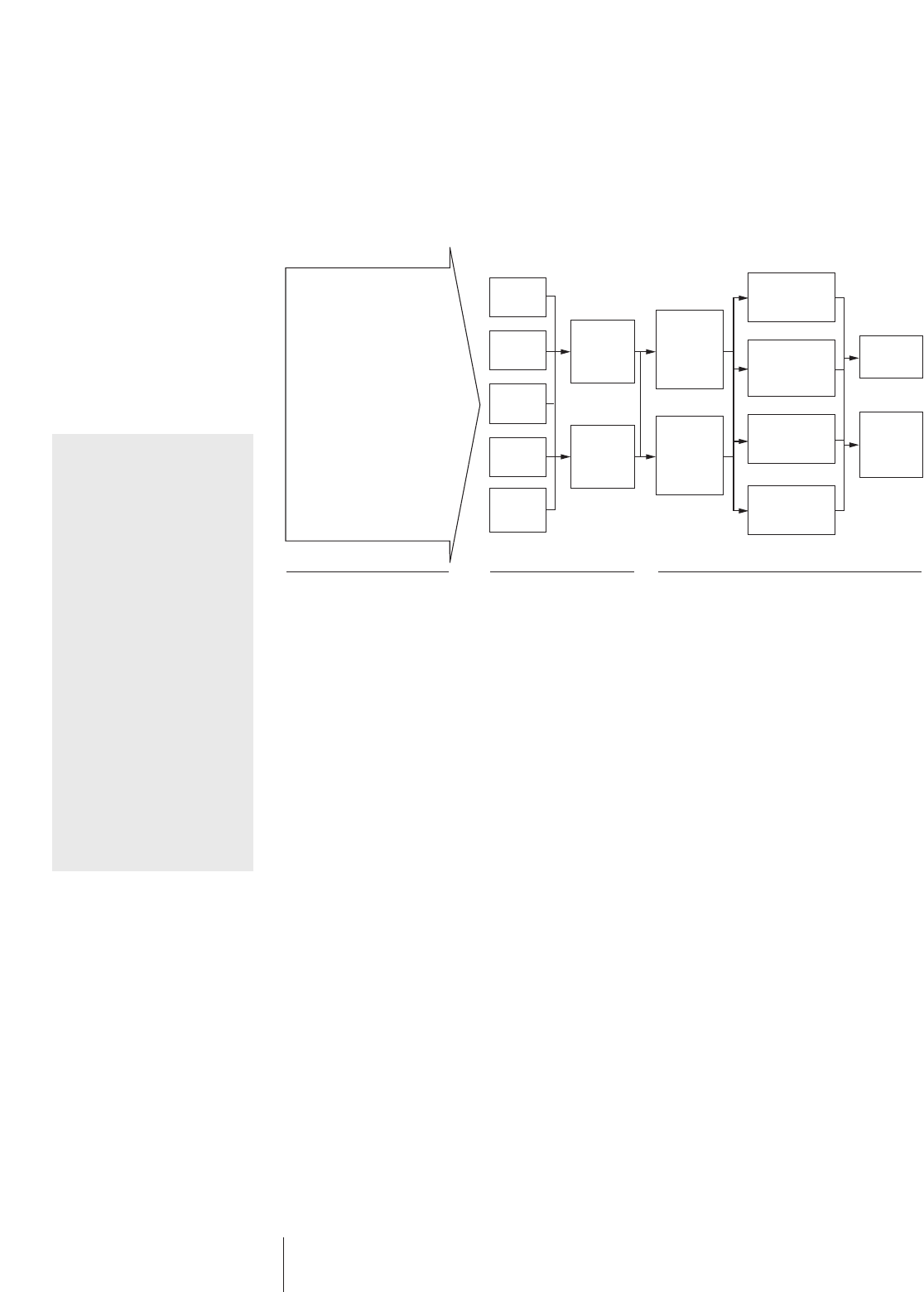
Working with Outcome Approach Models Highlights Activities and
Program Implementation
Outcome approach logic models display the interrelationships between specific program
activities and their outcomes. On the next page is an example drawn from the Calhoun
County Health Improvement Program, funded under the Comprehensive Community
Health Models of Michigan initiative.
This linear, columnar model emphasizes the causal linkages thought to exist among pro-
gram components. The arrows show which sets of activities program developers believed
would contribute to what outcomes. These statements serve as logical assertions about the
perceived relationship among program operations and desired results and are the hallmark
of the logic model process.
Notice that this model emphasizes “Your Intended Results” in the greatest relative detail
and anticipates achievement outside the time allotted for the initiative.
Logic Model Development GuidePage 11
These models help build a
common understanding
between managers and
evaluators.... Such agree-
ment is a prerequisite for
evaluation work that is
likely to be useful to man-
agement. [These models]
display the key events
(inputs, activities,
outcomes) that could be
monitored and the assumed
causal linkages that could
be tested in evaluations
of the program.
Joseph S. Wholey,
Harry P. Hatry, and
K.E. Newcomer (1994)
Assumptions
Health is a community issue and
communities will form partnerships
to resolve health care problems.
Commnities can influence and
shape public and market policy at
the local, state, and national levels.
External agents, working in
partnership with communities, can
serve as catalysts for change.
Shifting revenues and incentives to
primary care and prevention will
improve health status.
Information on health status and
systems is required for informed
decision making.
Your Beginnings Your Planned Work Your Intended Results
Outputs Outcomes ImpactInputs Activities
Active
Participation
in the Reform
Process
Inclusive
Community
Decision-
Making
Community-wide
Coverage and
Access
Comprehensive,
Integrated
Health Care
Delivery System
Community Health
Assessment
Community-based
Health Information
Systems
Improved
Health Status
Increased
Health Care
System
Efficiency
More Effective
Distribution of
Community
Health Care
Resources
Administrative
Processes for
Health Data,
Policy, and
Advocacy
External
Technical
Assistance
Consumers
Providers
Payers
Staff
Example of a Theory Logic model (Adapted from WKKF’s Comprehensive Community Health Models of
Michigan).
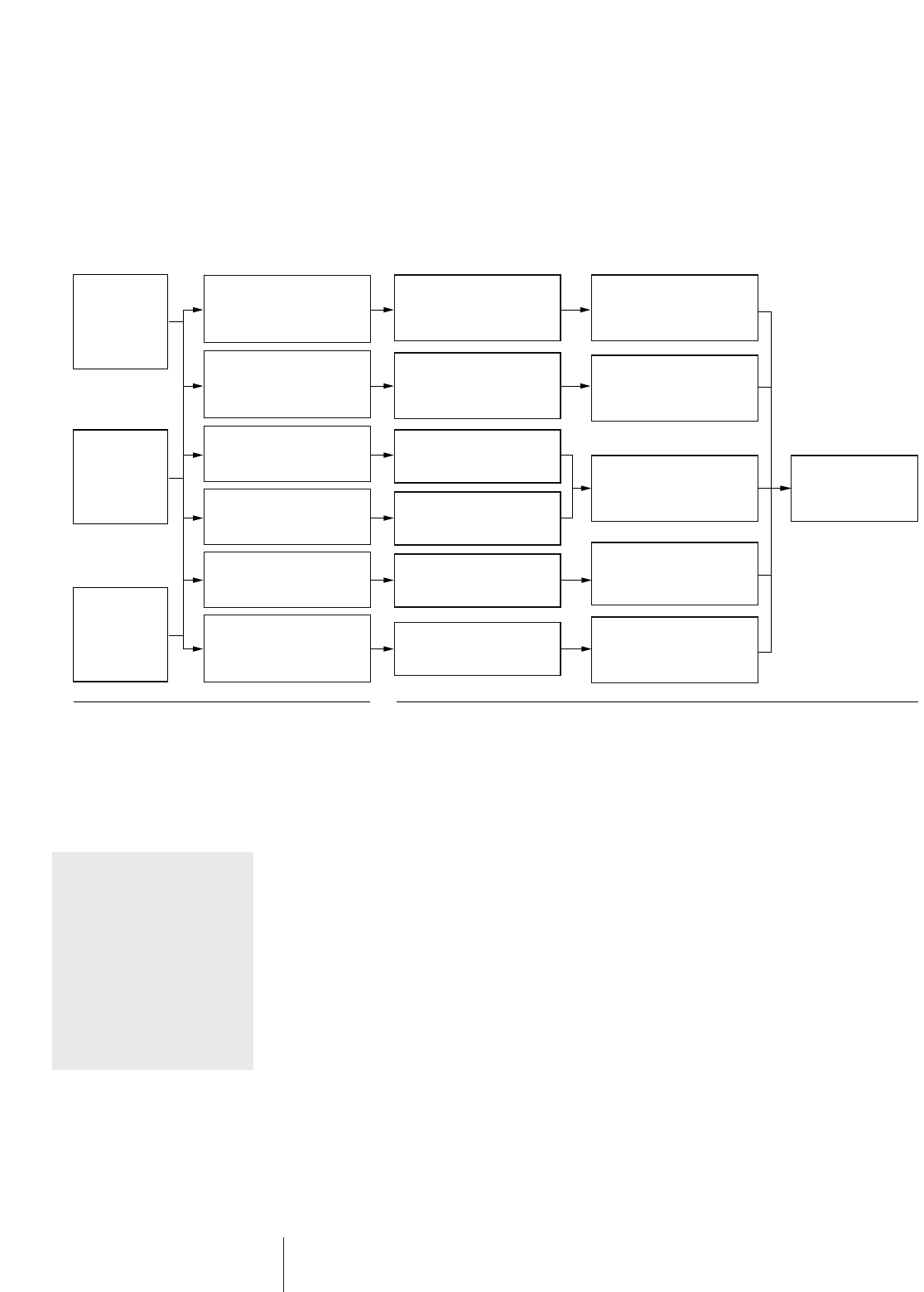
Using the Activities Approach Models to Track Outcomes
The activities approach logic model also connects program resources and activities to
desired results but does so in very great detail. Each outcome is usually dealt with sepa-
rately by the activities and events that must take place to keep the program on track.
The model emphasizing “Your Planned Work” can be used as a work plan or manage-
ment tool for program components and in conjunction with other models.
Notice how it points out what program activities need to be monitored and what kind of
measurements might indicate progress toward results. Below is one model describing the
connections between project tasks and outcome achievement for the community coverage
strand from the outcome approach example provided earlier.
Logic Model Development GuidePage 12
Not only will a logic model
clarify each element of your
program, it will enable you
to respond to the question:
“To what do I want to be
held accountable?”.
The Evaluation Forum
(1999)
Activities that encourage
consumers, providers, and payers
to seek support, and achieve
common goals.
Activities that increase consumer
awareness and access to health
promotion, disease prevention,
and primary care services.
Activities that increase linkages
among medical, health, and
human service systems.
Activities that lead to the
development of a community
access and coverage plan.
Activities that lead to the
development of a community
health information network.
Activities that lead to the
development of a community
health assessment and
reporting program.
Activities OutputsInputs
Consumers,
providers, and
payers to
participate in
governance
processes.
Sufficient staff with
expertise and
leadership skills to
implement the
program at the
local level.
Sufficient external
technical
assistance to
support staff in
program
implementation
Consumers, providers, and
payers serving on the CCHIP
Governing Board seek, support,
and achieve common goals.
Increased community access and
participation in health promotion,
disease prevention, and
primary care services.
Linkages are forged among
medical, health, and human
service systems.
Third-party administered contract
for community-wide coverage
is in place.
Fiber-optic information network
is in place (CHIN).
Community health assessment and
reporting program is in place.
CCHIP Governing Board is
deemed inclusive and
accountable by the
community stakeholders.
Increased numbers of community
members utilize the health
promotion, disease prevention,
and primary care service provided
Improved access/coverage for the
insured, under-, and non-insured
in the community.
Improved Health Status
Community members utilize the
CHIN for information collection,
storage, analysis, and exchange.
Information provided by the
Health Report Card is used to
make community health decisions.
Outcomes
Impact
Your Planned Work Your Intended Results
Chapter 1
Example of an Outcome Approach model (example drawn from the Calhoun County Health Improvement
Program, funded under the Comprehensive Community Health Models of Michigan initiative).
Adapted from the Calhoun County Health Improvement Program, one site of WKKF’s Comprehensive
Community Health Models of Michigan initiative
There Is No Best Logic Model
Try several on for size. Choose the model that fits your program best and provides the
information you need in the format that is most helpful. Like anything else, it takes prac-
tice to use logic models as effective program tools. We learn through trial and error to
find what works best for what program. Don’t hesitate to experiment with program logic
model design to determine what works best for your program. And don’t be concerned if
your model doesn’t look like one of the case examples.
The following show how the logic model forms gather information that can be used
throughout your program’s life – from defining the theory on which your program rests
to evaluating program impact.
Logic Model Development GuidePage 13
Insurance market issues are
identified and documented.
Insurance market issues are
prioritized based on potential
for successful reform.
The Purchasing Alliance will
identify insurance market issues
and strategies to reform those
identified issues will be
developed and implemented.
High priority issues are
identified and examined.
Strategies to reform the
high priority issues identified
have been developed.
Change agents with sufficient
capacity and resources to
successfully execute insurance
market reform are identified.
Equitable access to
community-wide coverage.
Change agents contracted to
implement insurance market
reform (minimum of 2).
% decrease of people
uninsured (201).
% decrease of new Medicaid
eligible consumers
achieving coverage before
in the hospital (203).
% in Medicaid participating
providers, using $1000
threshold level (204).
Deliverable–6
Your Planned Work Your Intended Results
Milestone Activities Outputs Outcomes
Activities to increase beneficiary
enrollment and provider
participation in Medicaid and
other third party sponsored
insurance and
reimbursment plans (2P1)
How to use a Logic Model Through the Life of Your Program:
Logic Model Development GuidePage 14
CLARIFYING PROGRAM THEORY:
1. PROBLEM OR ISSUE STATEMENT: Describe the problem(s) your program is attempting
to solve or the issue(s) your program will address.
2. COMMUNITY NEEDS/ASSETS: Specify the needs and/or assets of your community that
led your organization to design a program that addresses the problem.
3. DESIRED RESULTS (OUTPUTS, OUTCOMES AND IMPACTS): Identify desired results, or
vision of the future, by describing what you expect to achieve near- and long-term.
4. INFLUENTIAL FACTORS: List the factors you believe will influence change in your community.
5. STRATEGIES: List general successful strategies or “best practices” that have helped
communities like yours achieve the kinds of results your program promises.
6. ASSUMPTIONS: State the assumptions behind
how
and
why
the change strategies will
work in your community.
1. Program Planning
2. Program Implementation
3. Program Evaluation
DEMONSTRATING YOUR PROGRAM’S PROGRESS:
1. OUTPUTS: For each program activity, identify what outputs (service delivery/implementation
targets) you aim to produce.
2. OUTCOMES: Identify the short-term and long-term outcomes you expect to achieve for
each activity.
3. IMPACT: Describe the impact you anticipate in your community in 7 to 10 years with each
activity as a result of your program.
4. ACTIVITIES: Describe each of the activities you plan to conduct in your program.
5. RESOURCES: Describe the resources or influential factors available to support your program
activities.
PROGRAM EVALUATION QUESTIONS AND INDICATORS:
1. FOCUS AREA: From your program theory logic model, list the components of the most
important aspects of your program.
2. AUDIENCE: Identify the key audiences for each focus area. Who has an interest in your
program?
3. QUESTIONS: For each focus area and audience, list the questions they may have about
your program.
4. INFORMATION USE: For each audience and question you have identified, identify the ways
you will use the evaluation information.
5. INDICATORS: Describe what information could be collected that would indicate the status of
your program and its participants for each question.
6. TECHNICAL ASSISTANCE: Indicate the extent to which your organization has the evaluation
and data management expertise to collect and analyze the data that relates to this indicator.
Strategies
Assumptions
Problem or Issue
Influential
Factors
Desired Results
(outputs, outcomes,
and impact)
Community Needs/Assets
1
2
3
4
5
6
Focus Area
Question Indicators
Technical Assistance
Needed
“
RESOURCES
In order to accomplish
our set of activities we
will need the following:
ACTIVITIES
In order to address our
problem or asset we will
accomplish the following
activities:
OUTPUTS SHORT
We expect that once
accomplished these
activities will produce
the following evidence
or service delivery:
SHORT & LONG-TERM
OUTCOMES
We expect that if accom-
plished these activities
will lead to the following
changes in 1-3 then 4-6
years:
IMPACT
We expect that if accom-
plished these activities
will lead to the following
changes in 7-10 years:
Evaluation
Focus Area
Audience Question
Use
Chapter 1
For more detail, see the Program
Planning Template on p. 57.
For more detail, see the Evaluation
Planning Template on p. 59.
For more detail, see the Indicators
Development Template on p. 61.
For more detail, see the Program
Implementation Template on p. 54.

Developing a Basic Logic Model For Your Program
Drawing a picture of how your program will achieve results
W
hether you are a grantseeker developing a proposal for start-up funds or a
grantee with a program already in operation, developing a logic model can
strengthen your program. Logic models help identify the factors that will
affect your program and enable you to anticipate the data and resources you will need to
achieve success. As you engage in the process of creating your program logic model, your
organization will systematically address these important program planning and evaluation
issues:
• Cataloguing of the resources and actions you believe you will need to reach intended
results.
• Documentation of connections among your available resources, planned activities and
the results you expect to achieve.
• Description of the results you are aiming for in terms of specific, measurable, action-ori-
ented, realistic and timed outcomes.
The exercises in this chapter gather the raw material you need to draw a basic logic model
that illustrates how and why your program will work and what it will accomplish. You
can benefit from creating a logic model at any point in the life of any program. The logic
model development process helps people inside and outside your organization understand
and improve the purpose and process of your work.
Chapter 2 is organized into two sections – Program Implementation, and Program Results.
The best recipe for program success is to complete both exercises. (Full-size masters of each
exercise and the checklists are provided in the Forms Appendix at the back of the guide for
you to photocopy and use with stakeholder groups as you design your program.)
Exercise 1: Program Results. In a series of three steps, you describe the results you plan to
achieve with your program.
Exercise 2: Program Resources and Activities by taking you through three steps that con-
nect the program’s resources to the actual activities you plan to do.
The Mytown Example
Throughout Exercises 1 and 2 we’ll follow an example program to see how the logic
model steps can be applied. In our example, the folks in Mytown, USA, are striving to
meet the needs of growing numbers of uninsured residents who are turning to Memorial
Hospital’s Emergency Room for care. Because that care is expensive and not the best way
to offer care, the community is working to create a free clinic. Throughout the chapters,
Mytown’s program information will be dropped into logic model templates for Program
Planning, Implementation, and Evaluation.
Logic Model Development GuidePage 15
Chapter 2
Over the past few years, I
have markedly changed my
approach to logic modeling.
I have become convinced
that it makes a consider-
able difference if you do the
outcomes before planning
the activities.
I definitely advocate doing
the outcomes first! I find
that people come up with
much more effective activi-
ties when they do. Use the
motto, “plan backward,
implement forward.”
Beverly Anderson Parsons,
WKKF Cluster Evaluator

Novice logic modelers may want to have copies of the Basic Logic Model Template in
front of them and follow along. Those readers with more experience and familiarity may
want to explore the text and then skip ahead to the completed Basic Logic Model for the
Mytown Example on page 34.
Demonstrating Progress Toward Change
The Importance of Documenting Progress
According to many funders, grant applications frequently lack solid descriptions of how
programs will demonstrate their effectiveness. Some grantees think activities are ends unto
themselves. They report the numbers of participants they reach or the numbers of train-
ing sessions held as though they were results.
Conducting an activity is not the same as achieving results from the accomplishment of that
activity. For example, being seen by a doctor is different from reducing the number of unin-
sured emergency room visits. Tracking data like meetings held or patients enrolled does
monitor your program’s implementation and performance, but those data are outputs
(activ-
ity data), not outcomes (which refer to the results you expect to achieve in future years).
“Do the outcomes first” is sage advice. Most logic models lack specific short- and long-
term outcomes that predict what will be achieved several years down the road. Specifying
program milestones as you design the program builds in ways to gather the data required
and allows you to periodically assess the program’s progress toward the goals you identify.
For that reason, Exercise 1 isn’t filled out from left to right. This exercise asks you to
“do the outcomes first.” We will focus our attention first on what we have called “your
intended results.”
As you implement your program, outcome measures enhance program success by assess-
ing your progress from the beginning and all along the way. That makes it possible to
notice problems early on. The elements (Outputs, Outcomes, and Impact) that comprise
your intended results give you an outline of what is most important to monitor and gauge
to determine the effectiveness of your program. You can correct and revise based on your
interpretation of the collected data.
Exercise 1 – Describing Results
Describe the results you desire – Outputs, Outcomes and Impact
If you were running the Mytown Free Clinic, how would you show that your desired out-
come (a reduction in uninsured emergency care) didn’t result from a mass exodus of unin-
sured residents from Mytown, USA, or a sudden increase in number of employees offered
health insurance coverage by local businesses?
Logic Model Development GuidePage 16
Chapter 2

How will you demonstrate that your program contributed to the change you intend? A
well-crafted logic model can assert it is reasonable to claim that your program made a sub-
stantive contribution to your intended change. When programs operate in real communi-
ties where influences and forces are beyond your control, evaluation is generally more
about documenting a program’s contribution than about proving something. Community-
based initiatives operate in complex environments where the scientific certainty of “proof”
is seldom attainable. This is where logic models can be especially helpful.
INSTRUCTIONS: Exercise 1 will use the Basic Logic Model Development Template. In
particular, you will use the information presented in the gray text boxes that follow about
the Mytown example program to determine what results are intended for this program.
Example information about outcomes, impacts, and outputs are provided. You will fill in
the blank Basic Logic Model Development Template to illustrate first the outcomes and
impacts sought and then the outputs. You can then look at the completed template on
page 25 to see compare your interpretation with that produced by the Mytown folks.
Exercise 1 uses the Basic Logic Model Development Template
Outcomes and Impacts should be SMART:
• Specific
• Measurable
• Action-oriented
• Realistic
• Timed
Logic Model Development GuidePage 17
Resources
In order to accom-
plish our set of
activities we will
need the following:
Activities
In order to address
our problem or
asset we will con-
duct the following
activities:
Outputs
We expect that once
completed or under
way these activities
will produce the fol-
lowing evidence of
service delivery:
Short- & Long-
Term Outcomes
We expect that if
completed or ongo-
ing these activities
will lead to the fol-
lowing changes in
1–3 then 4–6 years:
Impact
We expect that if
completed these
activities will lead
to the following
changes in
7–10 years:

Some logic models number the lists within a column to aid discussion. Some tabular logic
models use rows to order and show the relationships among components. Some logic
models, like the outcome and activity examples provided in Chapter One, use a box and
arrow format to illustrate the “causal linkages” demonstrating how your resources, activi-
ties, outputs, outcomes, and impact connect to form chains. These depictions add to the
clarity of your logic model/evaluation plan. However, for the most basic of logic models,
the inventory approach we illustrate is sufficient to capture your thinking about how a
program will work. The other techniques will improve its utility, but the most important
task is to first get the component parts categorized and described. Once you have com-
pleted the inventory table for this and Exercise 2 feel free to experiment with identifying
the relationships among the items across columns.
Short-term outcomes are results you expect to achieve one to three years after a program
activity is under way.
Short-term outcomes are specific changes in things like attitudes, behaviors, knowledge,
skills, status, or level of functioning expected to result from program activities. These usu-
ally are expressed at an individual level among program participants.
Long-term outcomes are results you expect to achieve in four to six years.
Long-term outcomes are also specific changes in things like attitudes, behaviors, knowl-
edge, skills, status, or level of functioning expected to result from program activities.
These usually build on the progress expected by the short-term outcomes.
Logic Model Development GuidePage 18
EXAMPLES: Signed Memorandum of Agreement from the local technical college donating
clinic space, change in participants’ attitudes about the need for a medical home, increase in
numbers of scheduled annual physicals, increased patient follow-up visits, change in staff's
awareness of patient scheduling challenges, increased appropriate referrals from ER’s.
Insert Mytown’s short-term outcomes in the Short- and Long-Term Outcomes Column of the
Basic Logic Model Development Template
.
EXAMPLES: The clinic serves as a medical home for 500 uninsured patients. The clinic has
sustained funding sources: patient co-payments ($10/visit) provide 20% of the Clinic’s oper-
ating costs, United Way provides 20%, Memorial Hospital donates 20%, the Medical Society
contributes 20% and an endowment established at the Community Foundation provides the
final 20%. An annual golf tournament organized by the Kiwanis Club funds special clinic proj-
ects. There has been a 25% reduction in uninsured emergency care since Mytown Free Clinic
opened five years ago. In the Clinic’s fifth year there is a 15% reduction in uninsured ER vis-
its. Seventy-five volunteer administrators and 300 volunteer medical professionals regularly
serve at the clinic each year. Five companies donate all necessary medical supplies. Grant
funds purchase the computers and software needed to create electronic patient records. For
five years patient satisfaction ratings have been 90%.
Insert Mytown’s long-term outcomes in the Short- and Long-Term Outcomes column of the
Basic Logic Model Development Template
.
Chapter 2

Impact refers to the results expected seven to ten years after an activity is under way – the
future social change your program is working to create.
Impacts are the kinds of organizational, community, or system level changes expected to
result from program activities and which might include improved conditions, increased
capacity, and/or changes in the policy arena.
Outputs are data about activities.
They are the direct results of program activities. They are usually described in terms of
size and scope of the services or products delivered or produced by the program. They
indicate whether or not a program was delivered to the intended audiences at the intended
“dose.” A program output, for example, might include the number of classes taught, meet-
ings held, materials distributed, program participation rates, or total service delivery
hours.
Logic Model Development GuidePage 19
EXAMPLES: Specific reduction in inappropriate emergency room use, increased donations of
clinic supplies to meet identified needs, a stable supply of medical volunteers, an endowment
supporting 35% of the clinic’s operating funds, 900 patients served/year.
Insert Mytown’s impacts in the Impact Column of the Basic Logic Model Development
Template.
EXAMPLES: Number of patients referred to the Free Clinic from Memorial ER/year, the num-
ber of patients screened/year, the number of qualified patients enrolled in the Free Clinic/year,
the average number of patient visits/day, the total number of patient visits/year, the number
and specialties of medical volunteers, the number of volunteer administrators trained, the
number and locations of clinic posters distributed, the number of potential patients calling for
information/ month.
Insert Mytown’s outputs in the Outputs Column of the Basic Logic Model Development
Template.
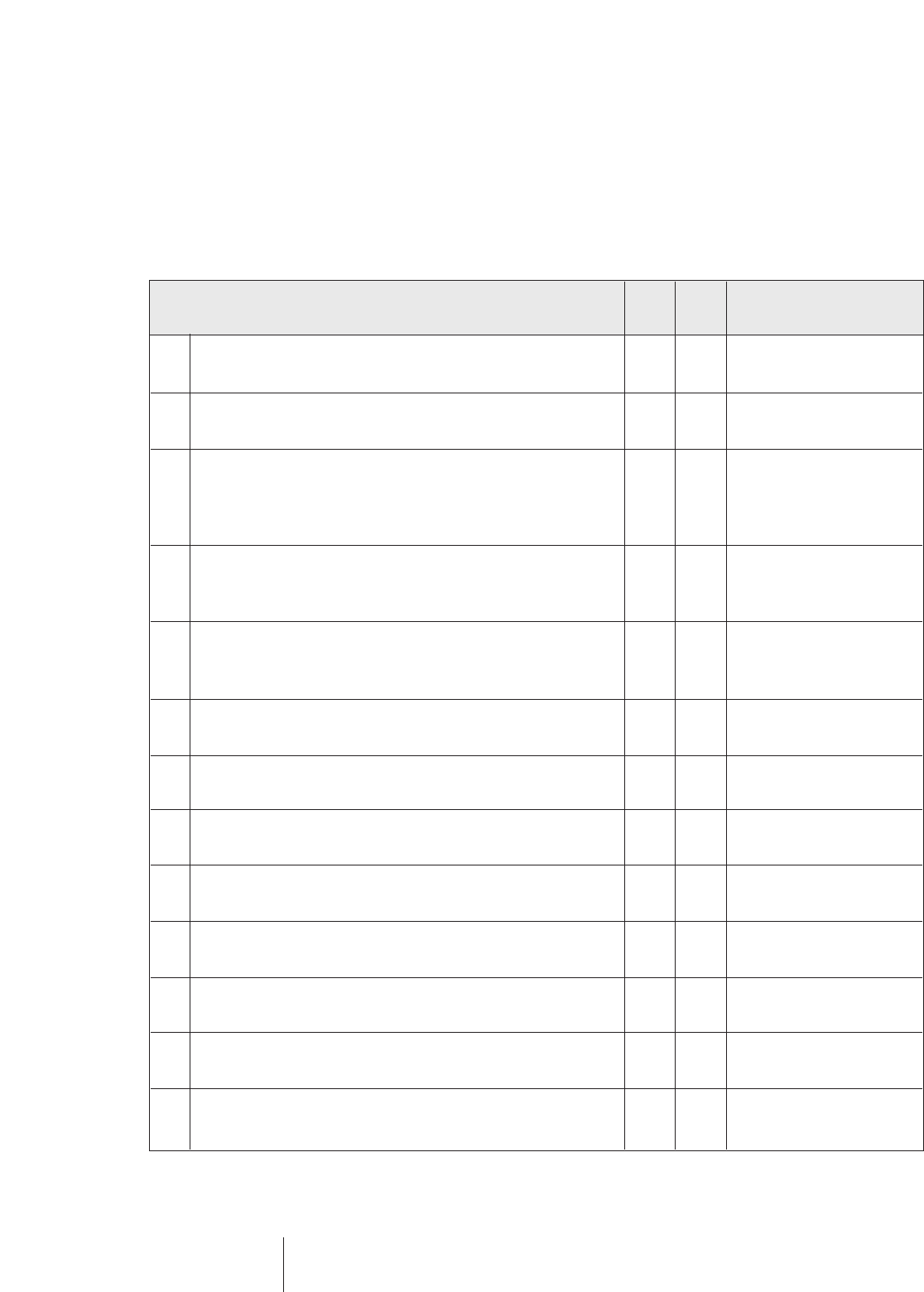
Exercise 1 Checklist:
Review what you have created using the checklist below to assess the quality of your draft.
Logic Model Development GuidePage 20
Progress Toward Results Quality Criteria
1. A variety of audiences are taken into consideration when
specifying credible outputs, outcomes, and impacts.
2. Target participants and/or partners are described and quanti-
fied as outputs (e.g. 100 teachers from 5 rural high schools).
3. Events, products, or services listed are described as outputs
in terms of a treatment or dose (e.g. 30 farmers will partici-
pate in at least 3 sessions of program, or curriculum will be
distributed to at least 12 agencies).
4. The intensity of the intervention or treatment is appropriate
for the type of participant targeted (e.g. higher-risk partici-
pants warrant higher intensities).
5. The duration of the intervention or treatment is appropriate
for the type of participant targeted (e.g. higher-risk partici-
pants warrant longer duration).
6. Outcomes reflect reasonable, progressive steps that partici-
pants can make toward longer-term results.
7. Outcomes address awareness, attitudes, perceptions, knowl-
edge, skills, and/ or behavior of participants.
8. Outcomes are within the scope of the program’s control or
sphere of reasonable influence.
9. It seems fair or reasonable to hold the program accountable
for the outcomes specified.
10. The outcomes are specific, measurable, action-oriented, real-
istic, and timed.
11. The outcomes are written as change statements (e.g. things
increase, decrease, or stay the same).
12. The outcomes are achievable within the funding and reporting
periods specified.
13. The impact, as specified, is not beyond the scope of the pro-
gram to achieve.
Comments
Revisions
Not
Yet
Yes
■■ ■■
■■ ■■
■■ ■■
■■ ■■
■■ ■■
■■ ■■
■■ ■■
■■ ■■
■■ ■■
■■ ■■
■■ ■■
■■ ■■
■■ ■■
Chapter 2

Exercise 2 – Describing Actions
Linking It All Together
Exercise 2 illustrates exactly how you plan to put your program theory to work. It leads
you to identify the resources and activities your program will need to achieve your intend-
ed results. This exercise documents your knowledge of the community resources you have
available and specific activities your program will implement.
Program rationales in grant proposals are usually strong. Grantees tend to have a very
good sense of what they want to do. However, they frequently fail to make specific
connections between their program and related best practice literature and practitioner
wisdom that could and should support their approach and their work.
To connect actions to program results, this exercise links your knowledge of what works
with specific descriptions of what your program will do. It requires you to anticipate what
will be needed to support program activities. The elements that comprise your program
implementation act as a game plan for the program you propose.
Most logic models list activity items and resources (like planning meetings, curriculum
purchase or design, training workshops, and service delivery). Depending on the nature
of your effort, other types of products and processes may be included. Management-
oriented logic models also include program and evaluation development, staff and volun-
teer training, recruitment of partners and participants, and the publicity needed to support
your work along the way.
As mentioned earlier, if your program addresses multiple issues you may find it helpful to
go through the exercises for each issue in turn and then aggregate them into a larger
model that highlights the relationships among issues.
We recommend referring to a literature review on the problem your program is designed
to address when you specify program activities. From this explicit knowledge of what
works, you can more clearly connect the abstract strategies supporting the program to its
concrete activities.
When Exercise 2 is complete and you are satisfied that you have an accurate inventory of
the Mytown program’s component parts, transfer the information to the Basic Logic
Model Development Template. Remember you have already filled in the three columns
on the right with what you have learned about the intended results for the Mytown pro-
gram example.
What activities are planned? Based on what you know about effective ways to solve
problems or build assets, what specific activities have you planned?
Logic Model Development GuidePage 21
I would emphasize that
people may well change
their minds about the
activities that are the most
useful after having done
the results work.
Beverly Anderson Parsons,
WKKF Cluster Evaluator

What resources are needed? Once you have specified what you plan to do, determine the
resources you will need to support the solutions your program proposes. For some types
of programs, it may also be helpful to describe the influential factors you are counting on
to support your efforts in the community.
Logic Model Development GuidePage 22
EXAMPLES: Personnel Committee launches and completes search for full-time director.
Director is hired and oriented to the board and the community. Board and staff visit the
Anywhere Free Clinic to learn from its experience and to select documents to replicate (i.e.,
policies and procedures, job descriptions, equipment needs, budgets, funding strategies, vol-
unteer and patient records). Board and staff conduct program-planning retreat. Based upon
Anywhere’s funding plan, board secures Free Clinic’s first-year funding. Marketing Committee
creates public relations campaign in collaboration with Volunteer Committee to secure volun-
teers and patients. Facility Committee creates and completes MOA with technical college to
secure a clinic facility. Quality Assurance Committee creates evaluation plan in cooperation
with Memorial Hospital’s Emergency Room staff and the local Chamber of Commerce.
Summarize Mytown’s activities in the Activities column of the Basic Logic Model
Development Template
EXAMPLES: Medical Society/Memorial Hospital Task Force for the Uninsured will become a
Free Clinic Board of Directors and secure a 501(c)(3) status from the IRS. The Board will
recruit 7–10 additional representatives from drug companies, the local technical school,
Mytown’s United Way, the Chamber of Commerce, the Community Foundation, the Volunteer
Center, the Nurses Association, etc. During a 6-month planning period, board committees will
be launched; staff will be recruited/hired/oriented; a site visit will be conducted; and the
Clinic’s first-year’s funding ($150,000/year) will be secured. Committees will create an MOA
with Memorial Hospital and the Medical Society to secure equipment required: 5 exam tables,
7 desks, 5 blood pressure cuffs, 5 otoscopes, 5 stethoscopes, 5 PDR’s, 1 set of scales, 10
thermometers, three computers, one first aid emergency kit.
Summarize Mytown’s resources in the Resources column of the Basic Logic Model
Development Template
.
Chapter 2

Exercise 2 Checklist:
Review what you have created using the checklist below to assess the quality of your draft.
Logic Model Development GuidePage 23
Theory into Action Quality Criteria
1. Major activities needed to implement
the program are listed.
2. Activities are clearly connected to the
specified program theory.
3. Major resources needed to implement
the program are listed.
4. Resources match the type of program.
5. All activities have sufficient and
appropriate resources.
Comments/Revisions
Not
Yet
Yes
■■ ■■
■■ ■■
■■ ■■
■■ ■■

Here we include a flowchart that summarizes the steps to complete your basic logic
model. Keep in mind that you could use this inventory style template to then further
describe the relationships among the components using numbered items, rows, or boxes
and arrows as we mentioned earlier.
Flowchart for Exercises 1 & 2 –
Describing Results, Resources, and Activities
Logic Model Development GuidePage 24
Exercise 1 Describing Results
Exercise 2 Describing Resources and Activities
Step 1.1
For each of the specific activities you have planned to do, what
short-term and then long-term outcomes do you expect to
achieve as indicators of the progress made by your program
toward its desired results?
Step 1.2
For each of the specific activities that you have planned to do,
what outputs (service delivery or implementation targets) do you
hope to reach through the operation of your program?
Step 1.3
For each of the specific activities you have planned to do, what
impact do you expect to achieve in your community?
Step 2.1
Knowing what you know about what works to solve problems or
build assets as specified in the theory of change for your pro-
gram, what specific activities have you planned to do?
Step 2.2
What resources are available to your program to support the
specific activities you have planned to do (for some programs, it
may also be important to state those influential factors you are
counting on to support your work)?
RESOURCES ACTIVITIES OUTPUTS OUTCOMES IMPACT
RESOURCES ACTIVITIES OUTPUTS OUTCOMES IMPACT
RESOURCES ACTIVITIES OUTPUTS OUTCOMES IMPACT
RESOURCES ACTIVITIES OUTPUTS OUTCOMES IMPACT
RESOURCES ACTIVITIES OUTPUTS OUTCOMES IMPACT
Chapter 2
OUTCOMES
OUTPUTS
IMPACT
ACTIVITIES
RESOURCES
3
4
5
1
2

Logic Model Development GuidePage 25
RESOURCES
In order to accomplish
our set of activities we
will need the following:
• IRS 501(c)(3) status
• Diverse, dedicated
board of directors
representing potential
partners
• Endorsement from
Memorial Hospital,
Mytown Medical
Society, and United
Way
• Donated clinic facility
• Job descriptions for
board and staff
• First year’s funding
($150,000)
• Clinic equipment
• Board & staff orienta-
tion process
• Clinic budget
ACTIVITIES
In order to address our
problem or asset we will
accomplish the following
activities:
• Launch/complete
search for executive
director
• Board & staff conduct
Anywhere Free Clinic
site visit
• Board & staff conduct
planning retreat
• Design and implement
funding strategy
• Design and implement
volunteer recruitment
and training
• Secure facility for clinic
• Create an evaluation
plan
• Design and implement
PR campaign
OUTPUTS
We expect that once
accomplished these
activities will produce
the following evidence
or service delivery:
• # of patients referred
from ER to the
clinic/year
• # of qualified patients
enrolled in the
clinic/year
• # of patient visits/year
• # of medical volunteers
serving/year
• # of patient flyers dis-
tributed
• # of calls/month seek-
ing info about clinic
SHORT- AND LONG-
TERM OUTCOMES
We expect that if accom-
plished these activities
will lead to the following
changes in 1–3 then 4–6
years:
• Memorandum of
Agreement for free
clinic space
• Change in patient atti-
tude about need for
medical home
• Change in # of
scheduled annual phys-
icals/follow-ups
• Increased # of
ER/physician referrals
• Decreased volume of
un-reimbursed emer-
gencies treated in
Memorial ER
IMPACT
We expect that if accom-
plished these activities
will lead to the following
changes in 7–10 years:
• Patient co-payments
supply 20% of clinic
operating costs
• 25% reduction in # of
uninsured ER
visits/year
• 300 medical volunteers
serving regularly each
year
• Clinic is a United Way
Agency
• Clinic endowment
established
• 90% patient satisfaction
for 5 years.
• 900 patients
served/year
Logic Model Development
Program Implementation Template – Exercise 1 & 2

Logic Model Development GuidePage 26

Developing a Theory-of-Change Logic Model
For Your Program
Drawing a picture of why your program should succeed
W
hether you are a grantseeker developing a proposal for start-up funds or a
grantee with a program already in operation, developing a logic model can
strengthen your program. Logic models help identify the factors that will
affect your program and enable you to anticipate the data and resources you will need to
achieve success. As you engage in the process of creating your program logic model, your
organization will systematically address these important program planning and evaluation
issues:
• Description of the change strategy that your program supports.
• Definition of the problem you are attempting to address.
• Quantification of the scope of the needs or assets that make the case for your selection
of the problem you address.
• Acknowledgement of the factors that may influence your ability to create change in
your community.
• Application of best practice research that supports plausible solution strategies for iden-
tified problem area.
• Statement of your assumptions about why your selected strategies will work in your
community in the ways you described.
Exercise 3: Program Planning constructs a program theory. Successful programs create
change and are built on a solid knowledge of what works – your program’s theory.
Exercise 3 guides you through a series of six steps that diagram the fundamental theory
that supports your program. This supports and builds upon the basic logic model. In
most cases, if you are developing a new program, this step should come first to inform
your preliminary thinking. We have placed it after basic logic models because it is a
slightly more complex exercise.
Logic Model Development GuidePage 27
Chapter 3

Exercise 3 – Constructing a Program Theory
Program Planning
The Importance of Framing Your Problems or Issues
with Sound Program Theory
Imagine you work for a funding organization. Each quarter you review a mountain of grant
proposals from worthy organizations doing good work. All of them need money. What
information would you require to determine which programs to fund? Funders tell us they
look for organizations that have done their homework by clearly defining the problem they
plan to address, describing the reasons behind their approach, and outlining how they antic-
ipate measuring their achievements. Funding decisions are more favorable if you can
demonstrate clearly how and why they will succeed. Logic models help you do just that.
Most grantees know what they want to do in their communities; Exercise 1 makes a
sound case for how and why funders should invest in your program.
It is crucial to begin program design with the basics. Funders encourage grantees to start by
clearly and succinctly explaining the problems they plan to address. Completing Exercise 1
describes the issues your program will address, identifies the needs and assets of your com-
munity that are related to your issues, and specifies why certain results are desired. Funders
and donors generally limit their investments to certain areas of interest, so if your program
addresses several issues, you may want to construct a logic model for each one.
Exercise 3 Uses The Theory-of-Change Template
Logic Model Development GuidePage 28
Strategies
Assumptions
Problem or Issue
Influential
Factors
Desired Results
(outputs, outcomes,
and impact)
Community Needs/Assets
1
2
3
4
5
6
Logic Model Development
Program Planning Template – Exercise 1
Chapter 3

INSTRUCTIONS: Exercise 3 will use the Theory-of-Change Template. In particular,
you will use the information presented in the gray text boxes that follow about the
Mytown example program to determine what theory-of-change was used to design and
develop this program. Example information about influential factors, the problem, com-
munity needs/assets, strategies, and assumptions are provided. You will fill in the blank
Theory-of-Change Template provided in the Forms Index (p. 57) to illustrate the pro-
gram theory for the Mytown example. You can then look at the completed template on
page 34 to compare your interpretation with that produced by the Mytown folks.
What problems are you attempting to solve or what issues are you striving to address? A
well-constructed program theory points toward your program’s eventual effectiveness.
Begin your problem statement explaining concisely the issue you will address, stating the
issue either as a community problem or asset. Your theory-of-change logic model will be
built upon this statement, which illustrates how the program will function and what it
expects to achieve in your community. It is smart to refer to research about your pro-
gram’s problem or issue in your statement; Internet searches can provide other successful
program or “best practice” information.
What needs or assets led you to address this issue? If a community needs assessment has
been conducted or if you have prioritized community needs and capacity, data exist that
make your case stronger and more specific by identifying and targeting your program’s
participants and activities. Documentation of community needs and assets also helps your
evaluation plan later on. It can become a baseline providing indicators that measure
progress made by your program over time. (Discussed in more detail in Chapter 4.)
Logic Model Development GuidePage 29
DOCUMENTED NEEDS/ASSETS EXAMPLE: Memorial Hospital’s Annual Report states that
28% of uninsured male patients, aged 40–55, received emergency room care in the previous
year. Last year’s United Way Community Needs Assessment identified health care for the
uninsured as the #1 community health care issue. The Medical Society and Memorial
Hospital’s Task Force on the Uninsured is researching ways to address the needs of the unin-
sured AND reduce costly, inappropriate ER use.
Insert Mytown’s community needs/assets in the Community Needs/Assets box of the
Theory-of-Change Template
.
PROBLEM STATEMENT EXAMPLE: There are increasing numbers of uninsured male workers,
aged 40–55, in Mytown, USA, due to local plant closings. As the bottom line of hospitals
shrink, the costs of uninsured care in local emergency rooms are negatively affecting local
health systems. To meet the human and financial needs of Mytown, USA, an accessible, free
medical home must be created to offer medical care and health education for Mytown’s unin-
sured residents.
Insert Mytown’s Problem or Issue in the Problem or Issue box of the Theory-of-Change
Template

What are your desired results? Identify what you expect your program to achieve in the
near and longer term. These become your outputs, outcomes and impact.
What influential factors (protective and/or risk) could influence change in your community?
What are the potential barriers and/or supports that might impact the change you hope
for? Are there policies or other factors that could affect your program?
Logic Model Development GuidePage 30
DESIRED RESULTS EXAMPLE: Increase accessible, affordable health care for the uninsured
and reduce the incidence of un-reimbursed care provided in emergency rooms. Create a free
clinic that combines an appropriate, accessible, free medical home and patient education to
reduce the numbers of uninsured males, aged 40–55, seeking care in emergency rooms.
Anticipate a 15%
in
crease in males, aged 40–55, with a free medical home and a 25%
de
crease in the incidence of uninsured men seeking care in the ER within 5 years.
Insert Mytown’s desired results (notice these are targeting men, which is more specific than
in the basic logic model example) in Desired Results box of the Theory-of-Change Template.
INFLUENTIAL FACTOR EXAMPLE: There is documented need for a free clinic. In its
Report
for the New Millennium
, the Mytown Chamber of Commerce projects a 35% increase in the
number of small businesses unable to afford employee health care benefits over the next five
years. There is strong community support for a free clinic. At the request of Mytown United
Way, Memorial Hospital and The Medical Society have created a joint task force to explore
the creation of a free clinic.
Insert Mytown’s influential factors in the Influential Factors box of the Theory-of-Change
Template.
Chapter 3

Flowchart for Exercise 3
Logic Model Development GuidePage 31
Strategies
Assumptions
Problem or Issue
Influential
Factors
Desired Results
(outputs, outcomes,
and impact)
Community Needs/Assets
1
2
3
4
5
6
Strategies
Assumptions
Problem or Issue
Influential
Factors
Desired Results
(outputs, outcomes,
and impact)
Community Needs/Assets
1
2
3
4
5
6
Strategies
Assumptions
Problem or Issue
Influential
Factors
Desired Results
(outputs, outcomes,
and impact)
Community Needs/Assets
1
2
3
4
5
6
Strategies
Assumptions
Problem or Issue
Influential
Factors
Desired Results
(outputs, outcomes,
and impact)
Community Needs/Assets
1
2
3
4
5
6
Strategies
Assumptions
Problem or Issue
Influential
Factors
Desired Results
(outputs, outcomes,
and impact)
Community Needs/Assets
1
2
3
4
5
6
Strategies
Assumptions
Problem or Issue
Influential
Factors
Desired Results
(outputs, outcomes,
and impact)
Community Needs/Assets
1
2
3
4
5
6
Program Planning – Clarifying Program Theory
1 Problem or Issue Statement
Describe the problem(s) your program is attempting to
solve or the issue(s) your program will address.
2 Community Needs/Assets
Specify the needs and/or assets of your community that
led your program to address the problem(s) or issue(s).
3 Desired Results (Outputs, Outcomes, and
Impacts)
Identify your desired results, or vision of the future, by
describing what you expect to achieve, near- or long-
term, if your program is funded.
4 Influential Factors
List the factors (e.g., protective or risk factors, existing
policy environment, or other factors) you believe will
influence change in your community.
5 Strategies
List general, successful strategies or “best practices”
your research identified that have helped communities
like yours achieve the kinds of results your program
promises.
6 Assumptions
State the assumptions behind
how
and
why
the identi-
fied change strategies will work in your community
(e.g., principles, beliefs, ideas).
For more detail, see the Program
Planning Template – Exercise 3
on p. 34.

Why do you believe your program will work? Look for strong rationale based on “best
practice” research that connects what you plan to do with why your approach will succeed.
Funders are eager for evidence that supports why you propose the solutions you do. It’s a
good idea to relate your approach to similar change strategies that have proven effective in
communities like yours. Reviewing literature and past evaluation reports from other pro-
grams (or your own work) will provide you with ample information to construct your pro-
gram rationale. The Internet makes it easier to research effective program strategies.
Why will your approach be effective? After you make the case for selecting a specific strategy
from among the alternatives you researched, state out loud why this strategy is needed and
why it will work in your community. It is important early on to document instances that
describe the general condition of public reaction to your problem/issue and possible solutions.
You should draw direct conclusions about the statement of need and capacities in your com-
munity in your assumption. In addition, it should be quite apparent how your program
intends to function as an intervention – to solve identified problems or build existing assets.
We list assumptions last in this exercise because in this abstracted learning format, the
logic modeler has the benefit of all the information that supports assumptions. They are
easier to spot and articulate with all the facts in front of you. In real-world conditions,
assumption are best stated up-front – much earlier in the logic model development
process – many basic logic models we have seen include a supporting page with the dia-
gram that lists the assumptions that belie the model drawn.
Logic Model Development GuidePage 32
PROGRAM STRATEGY EXAMPLE: A clinic using volunteer medical professionals reduced
emergency room care visits in Anothertown, USA, in 1997 by 25%. A free clinic in Mytown,
USA, using volunteer medical professionals could provide crucial, affordable medical homes
for growing numbers of uninsured residents preventing costly, inappropriate emergency
room use by males 40–55 experiencing coronary emergencies.
Insert Mytown’s strategies in the Strategies box of the Theory-of-Change Template.
ASSUMPTION EXAMPLE: As proven in Anothertown, access to affordable medical care
reduces the incidence of emergency visits by providing appropriate, preventive primary care.
A free medical clinic should prove successful in Mytown, because of its history of extraordi-
nary volunteerism. Mytown’s Medical Society officially encourages its 400 medical profes-
sional members to volunteer 20 hours each year to help medically underserved community
residents. Mytown’s Nursing Association is also interested in collaborating with a free clinic.
Memorial Hospital has agreed to assist in planning and funding a free clinic. There is prece-
dence for lending free facilities to medical projects serving those in need. Mytown’s technical
college donates space for Mytown’s volunteer dental clinic. Mytown’s Free Clinic will be
strongly supported by the people, businesses and institutions of Mytown, USA.
Insert Mytown’s assumptions in the Assumptions box of the Theory-of-Change Template.
Chapter 3

Exercise 3 Checklist:
After completing Exercise 3 and constructing your program theory, you can use the fol-
lowing checklist to assess the quality of your draft. It’s helpful if someone other than the
model’s creators reviews the first program draft and completes the checklist, too.
Logic Model Development GuidePage 33
Exercise Three Checklist
1. The problems to be solved/or issues to be addressed by
the planned program are clearly stated
2. There is a specific, clear connection between the
identified community needs/assets and the problems to
be solved (or issues to be addressed).
3. The breadth of community needs/assets has been
identified by expert/practitioner wisdom, a needs
assessment and/or asset mapping process.
4. The desired results/changes in the community and/or
vision for the future ultimately sought by program
developers are specific.
5. Influential factors have been identified and cited from
expert/practitioner wisdom and/or a literature review.
6. Change strategies are identified and cited from
expert/practitioner wisdom and/or literature review.
7. The connection among known influential factors and
broad change strategies has been identified.
8. The assumptions held for how and why identified
change strategies should work in the community are
clear.
9. There is consensus among stakeholders that the model
accurately describes the proposed program and its
intended results.
Comments
Revisions
Not
Yet
Yes
■■ ■■
■■ ■■
■■ ■■
■■ ■■
■■ ■■
■■ ■■
■■ ■■
■■ ■■
■■ ■■

Logic Model Development GuidePage 34
Strategies
Assumptions
Problem or Issue
Influential
Factors
Desired Results
(outputs, outcomes,
and impact)
Community Needs/Assets
1
2
3
4
5
6
Logic Model Development
Program Planning Template – Exercise 3
• Create a free clinic staffed primarily by volunteer physicians,
nurses, and pharmacists as in Anywhere, USA
• Ask doctors to see patients for free in their own
practices/Columbia, SC
• Mytown has a history of successful volunteer programs
• The Medical Society will encourage volunteers and provide on-going
support
• The clinic can find and operate in donated space
• The hospital will support a free clinic to improve patient health and to
save money
• Chamber predicts increase
in # of small businesses
unable to offer employee
health insurance
• There is a strong
community support for
a free clinic generated by
the Uninsured Task Force
• 3 major corporate leaders
have expressed interest in
a free clinic
• Increased #’s of uninsured workers
• Local plant closings limit jobs
• Costs of uninsured ER care are rising
• Hospitals cannot fund free ER care forever
• Memorial Hospital’s Annual Report states that 28% of
uninsured, male patients are seen in ER
• United Way Assessment lists health care for uninsured as
a top priority
• Memorial & Medical Society formed Task Force on
uninsured to research solutions
• Increased access to
affordable health care for
uninsured Mytown residents
• Create a free clinic to offer
affordable health care
+ education
• Decrease # of uninsured
patients seeking care in ER
• Increase # of uninsured
patients with a medical home

Using Your Logic Model to Plan for Evaluation
T
hinking through program evaluation questions in terms of the logic model com-
ponents you have developed can provide the framework for your evaluation plan.
Having a framework increases your evaluation’s effectiveness by focusing on ques-
tions that have real value for your stakeholders.
• Prioritization of where investment in evaluation activities will contribute the most use-
ful information for program stakeholders.
• Description of your approach to evaluation.
There are two exercises in this chapter; Exercise 4 deals with posing evaluation questions
and Exercise 5 examines the selection of indicators of progress that link back to the basic
logic model or the theory-of-change model depending on the focus of the evaluation and
its intended primary audiences.
Exercise 4 – Posing Evaluation Questions
The Importance of “Prove” and “Improve” Questions
There are two different types of evaluation questions – formative help you to improve
your program and summative help you prove whether your program worked the way you
planned. Both kinds of evaluation questions generate information that determines the
extent to which your program has had the success you expected and provide a ground-
work for sharing with others the successes and lessons learned from your program.
Benefits of Formative and Summative Evaluation Questions
3
Logic Model Development GuidePage 35
Chapter 4
Formative Evaluation – Improve
Provides information that helps you improve
your program. Generates periodic reports.
Information can be shared quickly.
Focuses most on program activities, out-
puts, and short-term outcomes for the pur-
pose of monitoring progress and making
mid-course corrections when needed.
Helpful in bringing suggestions for improve-
ment to the attention of staff.
Summative Evaluation – Prove
Generates information that can be used to
demonstrate the results of your program to
funders and your community.
Focuses most on program’s intermediate-
term outcomes and impact. Although data
may be collected throughout the program,
the purpose is to determine the value and
worth of a program based on results.
Helpful in describing the quality and effec-
tiveness of your program by documenting its
impact on participants and the community.
3
Adapted from Bond, S.L., Boyd, S. E., & Montgomery, D.L.(1997 Taking Stock: A Practical Guide to Evaluating
Your Own Programs, Chapel Hill, NC: Horizon Research, Inc. Available online at http://www.horizon-research.com.
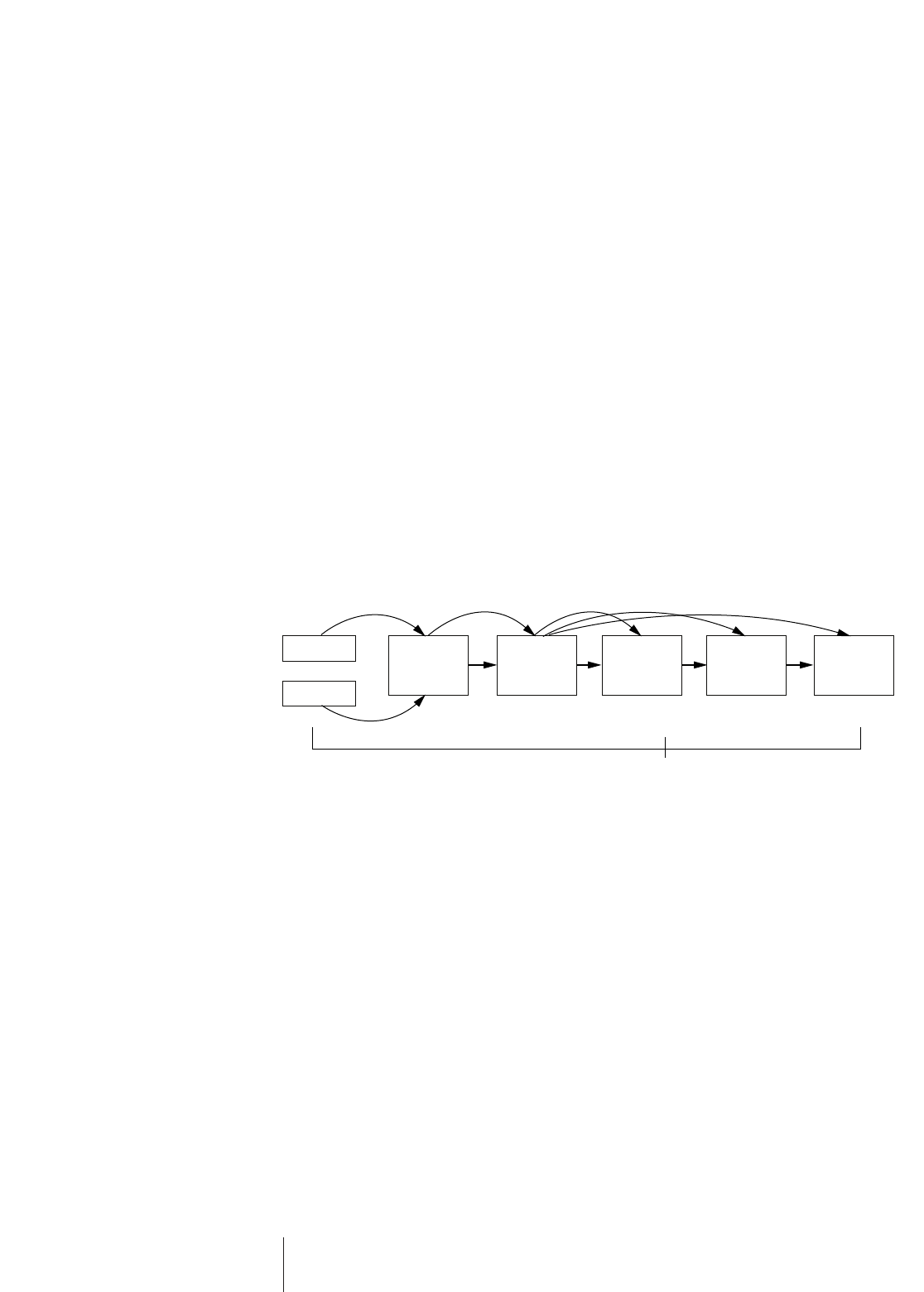
Looking at Evaluation from Various Vantage Points
How will you measure your success? What will those investing in your program or your
target audience want to know?
A clear logic model illustrates the purpose and content of your program and makes it eas-
ier to develop meaningful evaluation questions from a variety of program vantage points:
context, implementation and results (which includes outputs, outcomes, and impact).
What Parts of Your Program Will Be Evaluated?
Using a logic model to frame your evaluation questions.
Remember you can draw upon the basic logic model in Exercises 1 and 2 and the theory-
of-change model in Exercise 3. Feasibility studies and needs assessments serve as valuable
resources for baseline information on influences and resources collected during program
planning.
Context is how the program functions within the economic, social, and political envi-
ronment of its community and addresses questions that explore issues of program rela-
tionships and capacity. What factors might influence your ability to do the work you have
planned? These kinds of evaluation questions can help you explain some of the strengths
and weakness of your program as well as the effect of unanticipated and external influences
on it.
Logic Model Development GuidePage 36
Influences
Resources
Activities Outouts
Short-Term
Outcomes
Intermediate
Outcomes
Activities
Context
Relationships
& Capacity
Implementation
Quality &
Quantity
Outcomes
Effectiveness, Magnitude,
& Satisfaction
and/or
Summative EvaluationFormative Evaluation
What aspects of our situation
most shaped our ability to
do the work we set out to
do in our community?
What did our program
accomplish in our
community?
What is our assessment
of what resulted from our
work in the community?
What have we learned
about doing this kind
of work in a community
like ours?
Chapter 4
Outputs

Implementation assesses the extent to which activities were executed as planned, since a
program’s ability to deliver its desired results depends on whether activities result in the
quality and quantity of outputs specified. They tell the story of your program in terms of
what happened and why.
Outcomes determine the extent to which progress is being made toward the desired
changes in individuals, organizations, communities, or systems. Outcome questions seek
to document the changes that occur in your community as a result of your program.
Usually these questions generate answers about effectiveness of activities in producing
changes in magnitude or satisfaction with changes related to the issues central to your
program.
Logic Model Development GuidePage 37
Sample CONTEXT QUESTIONS: Can we secure a donated facility? With the low morale cre-
ated by high unemployment, can we secure the financial and volunteer support we need?
How many medical volunteers can we recruit? How many will be needed each evening? How
will potential patients find out about the clinic? What kind of medical care will patients need?
How can we let possible referral sources know about the clinic and its services? What sup-
plies will we need and how will we solicit suppliers for them? What is it about the free clinic
that supports its ability to reduce the numbers of patients seeking care in Memorial
Hospital’s ER?
SAMPLE IMPLEMENTATION QUESTIONS: What facility was secured? How many patients
were seen each night/month/year? What organizations most frequently referred patients to
the clinic? How did patients find out about the clinic? How many medical volunteers serve
each night/month/year? What was the value of their services? What was the most common
diagnosis? What supplies were donated? How many patients per year did the Clinic see in its
first/second/third year?
SAMPLE OUTCOME QUESTIONS: How many inappropriate, uninsured patients sought med-
ical care in Memorial’s ER in the Clinic’s first/second/third year? Was there a reduction in un-
funded ER visits? How did the number of uninsured patients compare to previous years
when the clinic was not operating? What was the cost/visit in the Free Clinic? What is the
cost/visit in Memorial’s ER? How do they compare? What were the cost savings to Memorial
Hospital? How satisfied were Clinic patients with the care they received? How satisfied were
volunteers with their service to the Clinic?

Creating Focus
Though it is rare, you may find that examining certain components of your program is
sufficient to satisfy your information needs. Most often, however, you will systematically
develop a series of evaluation questions, as shown in the Flowchart for Evaluation
Question Development.
Flowchart for Evaluation Question Development
Evaluation Focus Area
What is going to be evaluated?
List those
components from your theory and/or logic
model that you think are the most important
aspects of your program. These areas will
become the focus of your evaluation.
Audience
What key audience will have questions
about your focus areas?
For each focus
area you have identified, list the audiences
that are likely to be the most interested in
that area.
Question
What questions will your key audience have
about your program?
For each focus area
and audience that you have identified, list
the questions they might have about your
program.
Information Use
If you answer a given question, what will
that information be used for?
For each
audience and question you have identified,
list the ways and extent to which you plan to
make use of the evaluation information.
Logic Model Development GuidePage 38
The use of program theory
as a map for evaluation
doesn’t necessarily imply that
every step of every possible
theory has to be studied.
...Choices have to be made
in designing an evaluation
about which lines of
inquiry to pursue. ...The
theory provides a picture of
the whole intellectual land-
scape so that people can
make choices with a full
awareness of what they are
ignoring as well as what
they are choosing to study...
Weiss (1998)
Evaluation
Evaluation
Focus Area
Audience Question
Use
Evaluation
Focus Area
Audience Question
Use
Evaluation
Focus Area
Audience Question
Use
Evaluation
Focus Area
Audience Question
Use
1
2
4
Chapter 4
For more detail, see the Evaluation
Planning Template – Exercise 4
on p. 44.
1
2
3
4
1
EVALUATION
FOCUS AREA
2
AUDIENCE
QUESTION
3
INFORMATION USE
4

What is going to be evaluated?
For each area on which your program focuses, list the most important aspects of your
program theory and logic model. Focus your evaluation on them.
Focus Area Examples:
The benefits of asking and answering evaluation questions depend on how clear you are
about the purpose of your evaluation, who needs to know what when, and the resources
you have available to support the evaluation process.
Logic Model Development GuidePage 39
Context Examples — Evaluating relationships and capacity. How will the Free Clinic recruit
and train effective board and staff members? What is the best way to recruit, manage, retain
and recognize medical and administrative volunteers and other Clinic partners? What is the
most effective way to recruit and retain uninsured patients? How will the operation of a Free
Clinic affect Memorial Hospital’s expenses for providing uninsured medical care in its ER?
How many patients can Clinic volunteers effectively serve on a regular basis? What is the
ideal patient/volunteer ratio?
Insert focus areas into Focus Area Column of Evaluation Questions Development Template
for Evaluation Planning, Exercise 4
.
Implementation Examples – Assessing quality and quantity. How many major funding part-
ners does the clinic have? How are volunteers and patients scheduled? How many medical
volunteers serve Clinic patients on a regular basis? What is the value of their services? What
is the most common diagnosis at the Clinic? What is the most common diagnosis of unin-
sured patients seen in Memorial’s ER? How long do patients wait to be seen at the Clinic? Is
there a patient or volunteer waiting list?
Insert focus areas into Focus Area Column of Evaluation Questions Development
Template for Evaluation Planning, Exercise 4.
Outcomes – Measuring effectiveness, magnitude and satisfaction. Has the clinic increased
access to care for a significant number of Mytown’s uninsured citizens? How many residents
of Mytown, USA, do not have health insurance? How many patients does the Clinic serve on a
regular basis? What is that ratio? What is the cost per visit in the Clinic and Memorial’s ER?
How do the costs compare? What is the satisfaction level of Clinic patients and volunteers
with Clinic services and facilities? How many donors does the Clinic have? What is their satis-
faction with Clinic services and facilities? How effectively is the Clinic educating, engaging and
involving its partners? What organizations have officially endorsed the Clinic? What is the
board and staff’s satisfaction with clinic operations, facilities and services?
Insert focus areas into Focus Area Column of Evaluation Questions Development Template
for Evaluation Planning, Exercise 4
.

What Information Will Your Program’s Audiences Want?
As shown below, program audiences will be interested in a variety of different kinds of
information. Donors may want to know if their money did what you promised it would.
Patients might want to know how many patients the clinic serves and how many volun-
teers it has. Physicians donating their time and talent could be interested in the financial
value of their contributions. If you ask your audiences what they want to know, you’ll be
sure to build in ways to gather the evaluation data required.
How often do you have to gather data? Whether a question is more formative or summa-
tive in nature offers a clue on when information should be collected.
• Formative information should be periodic and reported/shared quickly to improve
your efforts.
• Summative tends to be “before and after” snapshots reported after the conclusion of the
program to document the effectiveness and lessons learned from your experience.
Logic Model Development GuidePage 40
Audience
Program
Management
and Staff
Participants
Community
Members
Public Officials
Funders
Typical Questions
Are we reaching our target population?
Are our participants satisfied with our program?
Is the program being run efficiently?
How can we improve our program?
Programming decisions, day-to-day operations
Did the program help me and people like me?
What would improve the program next time?
Is the program suited to our community
needs?
What is the program really accomplishing?
Who is the program serving?
What difference has the program made?
Is the program reaching its target population?
What do participants think about the program?
Is the program worth the cost?
Is what was promised being achieved?
Is the program working?
Is the program worth the cost?
Evaluation Use
Programming decisions,
day-to-day operations
Decisions about continu-
ing participation.
Decisions about partici-
pation and support.
Decisions about commit-
ment and support.
Knowledge about the
utility and feasibility of
the program approach.
Accountability and
improvement of future
grantmaking efforts.
Chapter 4

Involve Your Audience in Setting Priorities
Program developers often interview program funders, participants, staff, board and partners
to brainstorm a list of all possible questions for a key area identified from their program
theory or from their logic models. That list helps determine the focus of the evaluation.
Involving your audience from the beginning makes sure you gather meaningful informa-
tion in which your supporters have a real interest.
Prioritization is a critical step. No evaluation can answer all of the questions your pro-
gram’s audiences may ask. The following questions can help you narrow your number of
indicators: How many audiences are interested in this information? Could knowing the
answer to this question improve your program? Will this information assess your pro-
gram’s effectiveness?
The final focus for your evaluation is often negotiated among stakeholders. It is impor-
tant to keep your evaluation manageable. It is preferable to answer a few important
questions thoroughly than to answer several questions poorly. How well you can answer
your questions will depend on the time, money, and expertise you have at your disposal
to perform the functions required by the evaluation.
What key audiences will have questions about your evaluation focus
areas?
For each focus area that you identified in the previous step, list the audiences that are
likely to be most interested in that area. Summarize your audiences and transfer to the
Audience Column of the Evaluation Questions Development Template for Evaluation
Planning, Exercise 4.
Context – Relationships and Capacity
Implementation – Quality and Quantity
Outcomes – Effectiveness, Magnitude, and Satisfaction
Logic Model Development GuidePage 41
Example audiences: Medical professionals, Memorial Hospital Board and Staff (especially ER
staff), Medical associations, Foundations, The Chamber of Commerce, United Way, The
Technical College, uninsured residents, medical supply companies, local media, public officials.
Example audiences: Funders, In-kind donors, Volunteers, Board, Staff, Patients, Public
Officials, The media, Medical associations, Local businesses, Health care organizations.
Example audiences: Funders, In-kind donors, Medical and administrative volunteers, Board,
Staff, Patients, Public Officials, The media, Medical associations, Local businesses, Health
care organizations.

What questions will key audiences ask about your program?
For each focus area and key audience you identified in the previous step, list the questions
your stakeholders ask about your program. Insert summaries in the Question Column of
the Evaluation Questions Development Template for Evaluation Planning, Exercise 4 (on
page 44).
Sample of Key Audience Questions:
• Who are the collaborative partners for this program? What do they provide?
• What is the budget for this program?
• How many staff members does the program have?
• How many patients does the clinic serve?
• How many visits per year does the average patient have?
• What is the most common diagnosis?
• Does the clinic save the hospital money?
• How does the organization undertake and support program evaluation?
• How are medical volunteers protected from lawsuits?
• How satisfied are patients, volunteers, board and staff with the clinic’s services?
• What do experts say about the clinic?
• How many uninsured patients still seek inappropriate care in the ER? Why?
How will the evaluation’s information be used?
For each question and audience you identified in the previous step, list the ways and
extent to which you plan to make use of the evaluation information. Summarize audience
use of information. Insert in the Use Column of the Evaluation Questions Development
Template for Evaluation Planning, Exercise 4.
Context – Relationships and Capacity Examples
• Measure the level of community support.
• Assess effectiveness of community outreach.
• Assess sustainability of Clinic funding sources.
• Improve volunteer and patient recruitment methods.
• Secure additional Clinic partners.
Implementation – Quality and Quantity Examples
• Assess optimal number of volunteers and patients to schedule per session to improve
operating effectiveness while maintaining patient and volunteer satisfaction.
• Measure patient, volunteer, staff, board, donors and community satisfaction with clinic.
• Determine cost savings per visit. Share information with local medical and business
groups to encourage their support.
Logic Model Development GuidePage 42
Chapter 4

Outcomes and Impact – Examples of Effectiveness, Magnitude, and Satisfaction
• Cost savings of Clinic – use to obtain additional volunteer and financial support from
Memorial Hospital.
• Patient satisfaction survey results – use to improve patient services and satisfaction.
• Analysis of most frequent referral sources – use to present information seminars to ER
staff, social service workers and unemployment insurance clerks to increase patient refer-
rals and intakes.
• Analysis of most prevalent patient diagnoses – use to create relevant patient health edu-
cation newsletter. Patient tracking system will measure impact of education program.
Exercise 4 Checklist: After completing Exercise 4 you can use the following checklist to
assess the quality of your draft.
Logic Model Development GuidePage 43
Posing Questions Quality Criteria Yes Not Comments
Yet Revisions
1. A variety of audiences are taken
into consideration when
specifying questions.
2. Questions selected are those with
the highest priority.
3. Each question chosen gathers
useful information.
4. Each question asks only one
question (i.e. “extent of X, Y,
and Z” is not appropriate).
5. It is clear how the question
relates to the program’s logic
model.
6. The questions are specific about
what information is needed.
7. Questions capture lessons
learned about your work along
the way.
8. Questions capture lessons
learned about your program
theory along the way.
■■
■■
■■
■■
■■
■■
■■
■■
■■
■■
■■
■■
■■
■■
■■
■■

Logic Model Development GuidePage 44
Evaluation
Focus Area
Relationships
Outcomes
Audience
Funders
Medical Volunteers
Patients
Staff
Funders/Donors
Volunteers
Patients
Staff
Question
Is the program cost effective?
Are volunteers & patients satisfied with Clinic
services?
What is the most common diagnosis?
How will medical volunteers be protected from
lawsuits?
Am I receiving quality care?
How long can I receive care here?
Are we reaching our target population?
How do patients find us? What’s our best promo-
tional approach?
Program Budget?
Cost/visit?
Visits/month/year?
Cost savings for Memorial Hospital?
Volunteers/year?
Patient satisfaction
Patient & volunteer satisfaction
Common DRG(?)
Use
Cost benefits/fundraising
Program promotion/fundraising
Quality assurance/Planning
Volunteer recruitment
Program improvement & planning
" "
Evaluation/program promotion
Evaluation and/or improvement
Cost benefit analysis
"
Annual Report/program promotion/public relations
Annual Report/program promotion/fundraising
Annual Report/volunteer recruitment
Program improvements/staff training
"
Logic Model Development
Evaluation Planning Template – Exercise 4

Exercise 5 – Establishing Indicators
One of the biggest challenges in developing an evaluation plan is choosing what kind of
information best answers the questions you have posed. It is important to have general
agreement across your audiences on what success will look like. Indicators are the meas-
ures you select as markers of your success.
In this last exercise you create a set of indicators. They are often used as the starting point
for designing the data collection and reporting strategies (e.g., the number of uninsured
adults nationally, statewide, in Mytown, USA, or the number of licensed physicians in
Mytown). Often organizations hire consultants or seek guidance from local experts to con-
duct their evaluations. Whether or not you want help will depend on your organization’s
level of comfort with evaluation and the evaluation expertise among your staff.
Examples and Use of Indicators.
Logic Model Development GuidePage 45
The biggest problem is usu-
ally that people are trying
to accomplish too many
results. Once they engage in
a discussion of indicators,
they start to realize how
much more clarity they
need in their activities.
I also find that it is impor-
tant that the program, not
the evaluator, is identifying
the indicators. Otherwise,
the program can easily dis-
credit the evaluation by
saying they don’t think the
indicators are important,
valid, etc.
Beverly Anderson Parsons,
WKKF Cluster Evaluator
Focus Area
Influential Factors
Resources
Activities
Outputs
Outcomes &
Impacts
Indicators
Measures of influential factors – may
require general population surveys
and/or comparison with national data
sets
2
.
Logs or reports of financial/staffing
status.
Descriptions of planned activities.
Logs or reports of actual activities.
Descriptions of participants.
Logs or reports of actual activities.
Actual products delivered.
Participant attitudes, knowledge,
skills, intentions, and/or behaviors
thought to result from your activities
3
.
How to Evaluate
1
Compare the nature and extent
of influences before (baseline)
and after the program.
Compare actual resources
acquired against anticipated.
Compare actual activities
provided, types of participants
reached against what was
proposed.
Compare the quality and quan-
tity of actual delivery against
expected.
Compare the measures before
and after the program
4
.
1
This table was adapted from A Hands-on Guide to Planning and Evaluation (1993) available from the National AIDS
Clearinghouse, Canada.
2
You may want to allocate resources to allow for the assistance of an external evaluation consultant to access national data-
bases or perform statistical analyses.
3
Many types of outcomes and impact instruments (i.e. reliable and valid surveys and questionnaires) are readily available.
The Mental Measurement Yearbook published by the Buros Institute (http://www.unl.edu/buros/) and the ERIC
Clearinghouse on Assessment and Evaluation (http://ericae.net/) are great places to start.
4
You may need to allocate resources to allow for the assistance of an external evaluation consultant.

Our advice is to keep your evaluation simple and straightforward. The logic model tech-
niques you have been practicing will take you a long way toward developing an evaluation
plan that is meaningful and manageable.
Determine the kinds of data you will need and design methods to gather the data (i.e.,
patient registration forms, volunteer registration forms, daily sign-in sheets, national, state
and local statistics). Sometimes, once an indicator (type of data) is selected, program
planners set a specific target to be reached as an agreed upon measure of success (for
example 25% decrease in the numbers of inappropriate ER visits).
As in the previous exercises use the space below to loosely organize your thoughts. Then,
once the exercise is completed and assessed, use the Indicator Development Template on
page 61 to record your indicators and technical assistance needs.
Filling in the Flowchart for Indicator Development
What information will be gathered to “indicate” the status of your
program and/or its participants?
Column 1: Focus Areas – From the information gathered in Exercise 4, transfer the areas
on which your evaluation will focus into column one (for example, patient health, volun-
teer participation, sustaining supporting partnerships).
Column 2: Questions – transfer from Exercise 4 the major questions related to each focus
area – big questions your key audiences want answered. Remember to keep your evalua-
tion as simple as possible.
Column 3: Indicators – Specify the indicators (types of data) against which you will
measure the success/progress of your program. It’s often helpful to record the sources of
data you plan to use as indicators (where you are likely to find or get access to these data).
Column 4: Technical Assistance – To what extent does your organization have the evalua-
tion and data management expertise needed to collect and analyze the data that related to
each indicator? List any assistance that would be helpful – universities, consultants,
national and state data experts, foundation evaluation departments, etc.
Logic Model Development GuidePage 46
Focus Area
Question Indicators
Technical Assistance
Needed
“
1 2 3 4
Chapter 4

Exercise 5 Checklist: Review what you have created using the checklist below to assess
the quality of your evaluation plan.
Logic Model Development GuidePage 47
1. The focus areas reflect the
questions asked by a variety
of audiences. Indicators
respond to the identified focus
areas and questions.
2. Indicators are SMART–
Specific, Measurable, Action-
oriented, Realistic, and Timed.
3. The cost of collecting data on
the indicators is within the
evaluation budget.
4. Source of data is known.
5. It is clear what data collection,
management, and analysis
strategies will be most
appropriate for each indicator.
6. Strategies and required
technical assistance have been
identified and are within the
evaluation budget for the
program.
7. The technical assistance
needed is available.
Establishing Indicators
Quality Criteria
Yes Not
Yet
Comments
Revisions
■■
■■
■■
■■
■■
■■
■■
■■
■■
■■
■■
■■
■■
■■

Logic Model Development GuidePage 48
Focus Area
Relationships
Outcomes
Question
Are volunteers & patients
satisfied w/ clinic care?
Are we reaching our target
population?
How do patients find the
clinic?
Does the clinic save the
community $?
What does the clinic provide?
How has volunteering
affected doctors, nurses,
administrators and patients?
Indicators
• Patient satisfaction surveys
• Volunteer satisfaction tests
• % of clinic patients vs. % of uninsured citizens
in Mytown, USA
• # of qualified clinic patients/year
• Annual analysis of telephone referral log
• Referral question on patient intake form
• Cost/visit
• # of uninsured patients seen in hospital ER –
beginning the year before clinic opened
• Most common diagnosis
• Hospital cost/visit for common diagnosis
• Annual volunteer survey
• Patient satisfaction survey
• # of volunteers/year
• # of volunteers donating to clinic operations
Technical Assistance
Needed
Anywhere’s patient satisfaction surveys
Anywhere’s volunteer survey
Reports from Chamber of Commerce
Patient database creation
Telephone log database
Anywhere’s patient intake form
Budget figures; patient service records
Tracking database software
Strategic direction for analysis
DRG workbook/tables (hospital staff)
Input from hospital billing staff
Anywhere surveys and analysis instruments
Volunteer management database
Donor database (Raiser’s Edge?)
Logic Model Development
Indicators Development Template – Exercise 5

This Appendix provides information on print and electronic resources available to support you
in your logic model development process.
1. Logic Model Information and Examples
University of Nevada, Reno Western CAPT web site
http://www
.unr.edu/colleges/educ/captta/pr
ev/evaluate.htm
BJA Evaluation web site
http://www
.bja.ev
aluationwebsite.org
Schmitz, C. C. & Parsons, B. A. (1999). Everything you wanted to know about logic models
but were afraid to ask. Battle Creek, MI: W.K. Kellogg Foundation.
2. United Way of America’s Outcome Models
United Way of America web site
http://www
.unitedway.org/outcomes/contents.htm
Measuring program outcomes: A practical approach.
United Way of America
701 North Fairfax Street
Alexandria, VA 22314
(703) 836-7100
3. Definitions and Information on Program Theory and Evaluation
Program Theory Definitions
• A plausible and sensible model of how a program is supposed to work (Bickman, 1987, p. 5).
• The set of assumptions about the relationships between the strategy and tactics the program
has adopted and the social benefits it is expected to produce (Rossi, Freeman, & Lipsey,
1999, p.98).
• The full chain of objectives that links inputs to activities, activities to ... outputs, ... outputs to
... outcomes, and ... outcomes to ultimate goals constitutes a program’s theory
(Patton, 1997, p. 218).
• A set of interrelated assumptions, principles, and/or propositions to explain or guide social
actions (Chen, 1990, p. 40).
• An explanation of the causal links that tie program inputs to expected program outputs
(Weiss, 1998, p. 55).
• A chain of causal assumptions linking program resources, activities, intermediate outcomes,
and ultimate goals (Wholey, 1987, p. 78).
Logic Model Development GuidePage 49
Resources Appendix

Bickman, L. (Ed.). (1987). Using program theory in evaluation. New Directions for
Program Evaluation Series (no. 33). San Francisco: Jossey-Bass.
Chen, H. T. (1990). Theory driven evaluations. Newbury Park, CA: Sage.
Wholey, J. S. (Ed). (1987). Organizational excellence: Stimulating quality and communicat-
ing value. Lexington, MA: Lexington Books.
Wholey, J. S., Hatry, H. P., & Newcomer, K. E. (Eds.). (1994). Handbook of Practical
Program Evaluation. San Francisco: Jossey-Bass Publishers.
Weiss, C. H. (1998). Evaluation: Methods for studying programs and policies. (2nd Ed).
Upper Saddle River, NJ: Prentice Hall.
4. W.K. Kellogg Foundation Logic Model Examples
W.K. Kellogg Foundation Web site
http://www.wkkf.org
W.K. Kellogg Foundation Evaluation Handbook.
To order contact:
W.K. Kellogg Foundation
P.O. Box 550
Battle Creek, MI 49015
(800) 819-9997
[item number 1203]
Parsons, B. A. (1999). Making logic models more systemic. A paper presented at the Annual
Meeting of the American Evaluation Association, Orlando, FL, November 1999.
Parsons, B. A., Schmitz, Co (1999) Everything You Wanted to Know About Logic Models
But Were Afraid to Ask. A paper presented at the Annual Meeting of the American
Evaluation Association, Orlando, FL, November 1999.
5. Information about Logic Model Development and Use
The Evaluation Forum (1999). Outcomes for success.
The Evaluation Forum
1932 First Avenue, Suite 403
Seattle, WA 98101
(206) 269-0171
Logic Model Development GuidePage 50
Resources Appendix

Freddolino, P. P. (1999). The program logic model: What it is and how to teach it. A pre-
conference workshop presented at the 1999 Conference of the Michigan Association for
Evaluation, East Lansing, MI, May.
Targeting Outcomes of Programs.
http://deal.unl.edu/TOP/synopsis.htm
Innovation Network, Inc. electronic logic model development tool
http://www.inetwork.org
6. Evaluation Planning Information
W.K. Kellogg Foundation Web site
http://www.wkkf.org
W.K. Kellogg Foundation Evaluation Handbook.
To order contact:
W.K. Kellogg Foundation
P.O. Box 550
Battle Creek, MI 49015
(800) 819-9997
[item number 1203]
Taking Stock.
http://www.horizon-research.org
The Evaluation Forum (1994). A field guide to outcome-based program evaluation.
The Evaluation Forum
1932 First Avenue, Suite 403
Seattle, WA 98101
(206) 269-0171
Rossi, P. H., Freeman, H. E., & Lipsey, M. W. (1999). Evaluation: A systematic approach.
Thousand Oaks, CA: Sage.
Patton, M. Q. (1997). Utilization-focused evaluation: The new century text. Thousand
Oaks, CA: Sage.
Logic Model Development GuidePage 51

Logic Model Development GuidePage 52

This Appendix provides the worksheet templates and checklists for exercises 1-5:
Logic Model Development Program Planning and Implementation
Exercises 1 and 2 Template
Exercise 1 Checklist
Exercise 2 Checklist
Theory-of-Change Logic Model Development Planning
Exercise 3 Template
Exercise 3 Checklist
Logic Model Development Evaluation and Indicators Development
Exercise 4 Template
Exercise 4 Checklist
Exercise 5
Exercise 5 Checklist
Logic Model Development GuidePage 53
Forms Appendix

Logic Model Development GuidePage 54
RESOURCES
In order to accomplish
our set of activities we
will need the following:
ACTIVITIES
In order to address our
problem or asset we will
accomplish the following
activities:
OUTPUTS
We expect that once
accomplished these
activities will produce
the following evidence
or service delivery:
SHORT- & LONG-TERM
OUTCOMES
We expect that if accom-
plished these activities
will lead to the following
changes in 1–3 then 4–6
years:
IMPACT
We expect that if accom-
plished these activities
will lead to the following
changes in 7–10 years:
Logic Model Development
Program Implementation Template – Exercise 1 & 2
Forms Appendix

Exercise 1 Checklist
Logic Model Development GuidePage 55
Progress Toward Results Quality Criteria – 1
1. A variety of audiences are taken into consideration when
specifying credible outputs, outcomes, and impacts.
2. Target participants and/or partners are described and quanti-
fied as outputs (e.g. 100 teachers from 5 rural high schools).
3. Events, products, or services listed are described as outputs
in terms of a treatment or dose (e.g. 30 farmers will partici-
pate in at least 3 sessions of program, or curriculum will be
distributed to at least 12 agencies).
4. The intensity of the intervention or treatment is appropriate
for the type of participant targeted (e.g. higher-risk partici-
pants warrant higher intensities).
5. The duration of the intervention or treatment is appropriate
for the type of participant targeted (e.g. higher-risk partici-
pants warrant longer duration).
6. Outcomes reflect reasonable, progressive steps that partici-
pants can make toward longer-term results.
7. Outcomes address awareness, attitudes, perceptions, knowl-
edge, skills, and/ or behavior of participants.
8. Outcomes are within the scope of the program’s control or
sphere of reasonable influence.
9. It seems fair or reasonable to hold the program accountable
for the outcomes specified.
10. The outcomes are specific, measurable, action-oriented, real-
istic, and timed.
11. The outcomes are written as change statements (e.g. things
increase, decrease, or stay the same).
12. The outcomes are achievable within the funding and reporting
periods specified.
13. The impact, as specified, is not beyond the scope of the pro-
gram to achieve.
Comments/
Revisions
Not
Yet
Yes
■■ ■■
■■ ■■
■■ ■■
■■ ■■
■■ ■■
■■ ■■
■■ ■■
■■ ■■
■■ ■■
■■ ■■
■■ ■■
■■ ■■
■■ ■■

Exercise 2 Checklist
Logic Model Development GuidePage 56
Theory into Action Quality Criteria
1. Major activities needed to implement
the program are listed.
2. Activities are clearly connected to the
specified program theory.
3. Major resources needed to implement
the program are listed.
4. Resources match the type of program.
5. All activities have sufficient and
appropriate resources.
Comments/Revisions
Not
Yet
Yes
■■ ■■
■■ ■■
■■ ■■
■■ ■■
Forms Appendix

Exercise 3 Checklist
Logic Model Development GuidePage 58
Exercise Three Checklist
1. The problems to be solved/or issues to be addressed by
the planned program are clearly stated
2. There is a specific, clear connection between the
identified community needs/assets and the problems
to be solved (or issues to be addressed).
3. The breadth of community needs/assets has been
identified by expert/practitioner wisdom, a needs
assessment and/or asset mapping process.
4. The desired results/changes in the community and/or
vision for the future ultimately sought by program
developers are specific.
5. Influential factors have been identified and cited from
expert/practitioner wisdom and/or a literature review.
6. Change strategies are identified and cited from
expert/practitioner wisdom and/or literature review.
7. The connection among known influential factors and
broad change strategies has been identified.
8. The assumptions held for how and why identified
change strategies should work in the community are
clear.
9. There is consensus among stakeholders that the model
accurately describes the proposed program and its
intended results.
Comments/
Revisions
Not
Yet
Yes
■■ ■■
■■ ■■
■■ ■■
■■ ■■
■■ ■■
■■ ■■
■■ ■■
■■ ■■
■■ ■■
Forms Appendix

Exercise 4 Checklist
Logic Model Development GuidePage 60
Posing Questions Quality Criteria Yes Not Comments/
Yet Revisions
1. A variety of audiences are taken
into consideration when
specifying questions.
2. Questions selected are those with
the highest priority.
3. Each question chosen gathers
useful information.
4. Each question asks only one
question (i.e. “extent of X, Y,
and Z”) is not appropriate).
5. It is clear how the question
relates to the program’s logic
model.
6. The questions are specific about
what information is needed.
7. Questions capture lessons
learned about your work along
the way.
8. Questions capture lessons
learned about your program
theory along the way.
■■
■■
■■
■■
■■
■■
■■
■■
■■
■■
■■
■■
■■
■■
■■
■■
Forms Appendix

Exercise 5 Checklist
Logic Model Development GuidePage 62
1. The focus areas reflect the
questions asked by a variety
of audiences. Indicators
respond to the identified focus
areas and questions.
2. Indicators are SMART–
Specific, Measurable, Action-
oriented, Realistic, and Timed.
3. The cost of collecting data on
the indicators is within the
evaluation budget.
4. Source of data is known.
5. It is clear what data collection,
management, and analysis
strategies will be most
appropriate for each indicator.
6. Strategies and required
technical assistance have been
identified and are within the
evaluation budget for the
program.
7. The technical assistance
needed is available.
Establishing Indicators
Quality Criteria
Yes Not
Yet
Comments/
Revisions
■■
■■
■■
■■
■■
■■
■■
■■
■■
■■
■■
■■
■■
■■
Forms Appendix


EV3815
Item #1209
0305 5M SCG
Printed on Recycled Paper
One Michigan
Avenue East
Battle Creek, MI
49017-4012
USA
269-968-1611
TDD on site
Facsimile: 269-968-0413
www.wkkf.org
W.K.KELLOGG
FOUNDATION



